Apollo 12
Day 1, part 1: Launch and Reaching Earth Orbit
Corrected Transcript and Commentary Copyright © 2004 - 2022 by W. David Woods, Johannes Kemppanen and Lennox J. Waugh. All rights reserved.
Last updated 2022-11-10
This is Apollo Saturn Launch Control. We’re now at T minus 8 hours, 58 minutes and counting. We have resumed the count after our built-in hold. We resumed at 1:22 am on schedule. As we pick up the count, we’ll be preparing to clear the pad as preparations are made for loading cryogenics aboard the Apollo Saturn V Launch Vehicle. The cryogenics, liquid hydrogen and liquid oxygen, will be loaded beginning at about the T minus 7-hour mark. We have a new weather forecast just came in. The front, which began passing through here late yesterday, and it’s been here since that time, has slowed down somewhat and is not expected to now move through by launch time as was earlier predicted. However this is not going to be a constraint to launch as presently viewed. We’ll be looking for winds, 15 to 20 knots. This is at the 60-foot [18-metre] level. There’ll be - There will be a 30 per cent chance of light showers at launch time. Be looking for a ceiling somewhere around 10,000 feet [3,000 metres] with broken clouds. There will be occasional showers at launch time. Visibility outside the showers will be about 10 miles [18.5 km]. All going well as we have resumed our count now at 8 hours, 57 minutes and counting; this is Kennedy Launch Control.
This is Apollo Saturn Launch Control. We’re at T minus 8 hours, 30 minutes and counting. T minus 8 hours, 30 minutes and counting; and we’re continuing to clear the pad in preparation for cryogenic loading. Mobile Service Structure was moved back last evening. It will remain now at its parked site, which is some 7,000 feet [2,130 metres] from the pad, through the launch. This Mobile Service Structure affords access to the space vehicle while it's at the pad and also affords weather protection for the spacecraft. When we begin cryogenic loading, we’ll begin by loading the liquid oxygen aboard the S-IVB or third stage of the Saturn launch vehicle. Liquid oxygen is an extremely cold fluid so it's necessary to prepare the pumps, lines and overall systems before bringing this aboard. It will be brought aboard at a very slow fill rate up to the 5 per cent fill mark. This slow rate is 500 gallons [1,890 litres] per minute. Once the proper cooling has been achieved we’ll move into the fast fill and that is some 10,000 - 1,000 gallons [3,790 litres] per minute. President Nixon called Apollo 12 commander Charles Conrad last night. He wished the crew a successful journey and invited the astronauts and their wives to dinner and to spend the night at the White House when they return from the Moon. The crew retired about 9 pm last night. They’ll be awakened at 6:05 this morning, have a brief medical exam, breakfast. They are expected to depart from the Manned Spacecraft Operations Building for the pad at approximately 8:27 am They should be at the pad and entering their spacecraft at about 8:45. Our countdown continues to go well. T minus 8 hours, 28 minutes and counting; this is Kennedy Launch Control.
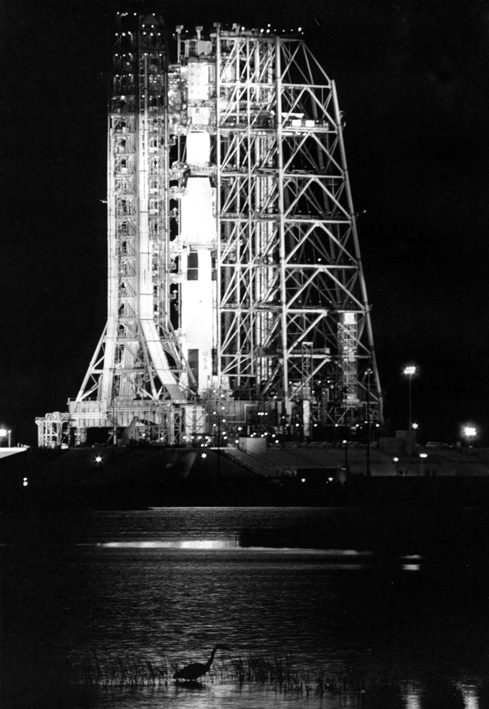
The Apollo 12 space vehicle photographed the night before launch with the Mobile Service Structure just prior to being taken to its parking site.
This is Apollo Saturn Launch Control; T minus 8 hours, 5 minutes and counting. All is going well with the countdown for Apollo 12 at this time. All personnel have now been cleared off the pad in preparation for cryogenic loading. The pre-cooling of the systems aboard the S-IVB stage, the first stage to receive the liquid oxygen, has been completed. And we’re standing by now to go into the fast fill of that stage. As we begin fast fill of the S-IVB or third stage, we’ll also begin to precool the S-II stage, the second stage of the Saturn V. The filling of the cryogenics is carried out in this manner. The liquid oxygen is first brought aboard the third stage. When that is completed, go into the fill of the second stage. When that is completed will move right into the fill of the first stage. Then we begin the liquid hydrogen loading following liquid oxygen loading. This is started by loading the second stage and then going into the third stage. The first stage fuel is RP-1. This is not a cryogenic fuel. It can be stored at ambient temperatures and it's been aboard the launch vehicle. All going well with our countdown at this time. T minus 8 hours, 4 minutes and counting; this is Kennedy Launch Control.
This is Apollo Saturn Launch Control. We’re now at 7 hours, 45 minutes and counting. Our count continues to go well as we’re now in the fast fill, that’s filling 1,000 gallons [3,790 litres] per minute, the liquid oxygen aboard the third stage or S-IVB stage of the Saturn V launch vehicle. It will be necessary after completing this fill to continue to replenish the liquid oxygen supply aboard the third stage. There is some boil-off which does occur. This is vented to the outside and to ensure a full load at launch time, it will be - continue to be replenished. This is true with also the first and second stages. We now have a report that we have some 25 per cent LOX aboard the third stage of the vehicle. To report the weather forecast given earlier, the front which was expected to move through here and be past here by launch time, has slowed down considerably and is expected to still be in the area at launch time. However this does not present constraints to launch as we see it at this time. We’ll be looking for winds from the west at 15 to 20 knots, a 30 per cent chance of light showers in the area at launch time with a ceiling of approximately 10,000 feet [3,000 metres]. Visibility outside of the showers will be approximately 10 miles [18.5 km] at launch time. Tonight, with the lights on the 363-foot [111-metre] tall Saturn V Apollo, we have word that the vehicle is easily seen from the roadways as far as 20 miles [if statute miles then 32 km] away. The liquid hydrogen, which is the fuel for the second and third stage, will be brought aboard following liquid oxygen loading. The systems are being chilled down at this time. As they are chilled down with the liquid hydrogen, there is some boil-off there also. These vapours are quite flammable. They're not vented to the atmosphere but are carried to a burn pond which is north of the pad. This burn pond also is easily visible at this time. This is a perfectly normal situation. Now T minus 7 hours, 43 minutes and counting; this is Kennedy Launch Control.
This is Apollo Saturn Launch Control. We’re now at T minus 7 hours and counting, T minus 7 hours and counting. Still bringing aboard the cryogenic liquid oxygen now coming aboard the second stage. The S-IVB or third stage fill was complete. That stage holds 189,900 pounds [86,137 kg] of liquid oxygen, some 19,766 gallons [74,822 litres]. Fast fill rate now moving into the second stage is 4,500 gallons [17,000 litres] per minute. A full complement aboard the S-II or second stage will be 820,710 pounds [372,267 kg] or 86,208 gallons [326,333 litres]. Cryogenic loading has proceeded smoothly this evening. Now at T minus 7 hours and counting; this is Apollo Saturn Launch Control.
This is Apollo Saturn Launch Control. We’re now at T minus 6 hours, 34 minutes and counting. We have completed loading the liquid oxygen aboard the S-II second stage and have now started the slow fill aboard the first stage. The huge first stage tanks will take some 3,308,605 pounds [1,500,757 kg] of liquid oxygen or 340,531 gallons [1,289,050 litres]. Our slow fill rate aboard the S-IC stage will continue to the 6½ per cent mark. That slow fill rate is between 1,100 and 1,200 gallons [4,164 and 4,542 litres] per minute. When we move into the fast fill, it will pour into those huge tanks at some 10,000 gallons [37,850 litres] per minute. Now starting the fill of the first stage with liquid oxygen. At T minus 6 hours, 34 minutes and counting; this is Kennedy Launch Control.
This is Apollo Saturn Launch Control. We're now at T minus 6 hours and counting as we continue to load cryogenics at this time; the liquid oxygen aboard the Saturn V vehicle. Liquid oxygen now coming aboard the first stage at the fast fill rate of 10,000 gallons per minute. Our weather forecast for 11:22 am launch is as follows. We'll be looking for winds 15 to 20 knots. The front which was expected to have passed by that time has slowed down and it looks like now we will have some light showers at the time of launch. There is approximately a 30 per cent chance of showers at launch time. However this does not present a constraint to launch. We're expecting a ceiling of 10,000 feet [3,000 metres], visibility of 10 miles [18.5 km] outside of the showers. Last night President Nixon called - Last night President Nixon called astronaut Charles Conrad, the Apollo 12 commander, and wished them well on their journey and invited the crew and their wives to dinner and an overnight stay once they get back from their journey. Now at T minus 5 minutes, 58 seconds [sic] and counting; this is Apollo Saturn Launch Control.
This is Apollo Saturn Launch Control at T minus 5 hours, 19 minutes and counting. We’re proceeding on our countdown satisfactorily at this time for the Apollo 12 mission. At this point in the count, one of the major highlights of the final portion of the countdown, the overall propellant loading of the three stages of the Saturn V launch vehicle is still in progress at this time. At this point we have just completed the full load of liquid oxygen to all three stages. We started earlier this morning loading first the third stage. Actually we load the liquid oxygen from top to bottom. First third stage then second stage and we just had a report a few moments ago from the Test Supervisor and the Launch Vehicle Test Conductor that we had completed the loading got some more than 348,000 gallons [1,317,000 litres] alone of liquid oxygen into the first stage of the Saturn V space vehicle. Coming up shortly, we’ll - we’ll begin the loading of the hydrogen fuel aboard the second and third stages. This is the final phase of the propellant loading. Overall, we’ll probably be loading close to three quarters of a million gallons [2,800,000 litres] of liquid oxygen and hydrogen aboard the Saturn V during this portion of the count. The prime crew for the Apollo 12 mission, astronauts Pete Conrad, Richard Gordon and Alan Bean, still should be asleep in the crew quarters at this time. According to the countdown, they'll be awakened just about an hour from this time. The countdown has proceeded generally satisfactorily since we resumed at 1:22 am Eastern Standard Time this morning. One minor problem did develop that was concerned with some ground support equipment located in the Mobile Launcher at the pad. A short while ago, it was necessary to send three crewmen to the launch pad inside the Mobile Launcher deck to change a printed circuit card inside the Mobile Launcher. This printed circuit card is used in combination with other ground support equipment to send test programs to the flight control computer in the Instrument Unit aboard the Saturn V. We determined from here in the Control Centre that we had a faulty printed circuit card. Whether it was cracked or what the difficulty was is not known at this time. However this printed circuit card has been replaced and we are now in a position to continue our checks throughout the remainder of the countdown of the flight control computer. To repeat, this was a strictly a ground support problem. It was not concerned with onboard flight equipment. This printed circuit card, used in associated with other techniques, was inside as far as our ground control is concerned, to interrogate the flight computer and the gyros in the Instrument Unit. We changed the card. The crewmen reported that all was well. They have left the launch pad and we are proceeding. Now coming up on 5 hours, 16 minutes. We’re still aiming toward our planned lift-off of 11:22 am Eastern Standard Time. Weather is Go. The weather prediction is Go for a launch attempt this morning as far as winds are concerned and the various launch parameters required for this flight. 5 hours, 15 minutes, 43 seconds and counting; this is Kennedy Launch Control.
This is Apollo Saturn Launch Control. T minus 4 hours, 48 minutes and counting. We're still proceeding satisfactorily with our Apollo 12 countdown at this time. At this point we’re in the midst of the liquid hydrogen fuel loading of the second stage of the Saturn V launch vehicle and we have about 51 per cent of the liquid hydrogen supply now aboard. We’ve already loaded all three stages with liquid oxygen for the flight and the final phase of the propellant loading is in progress, that is bringing the hydrogen fuel aboard first, the second stage, then the S-IVB, the third stage of the Saturn V vehicle. All has been going well in the propellant loading. This is a major highlight of the final portion of the countdown and it lasts some 4½ hours as we bring more than three quarter of a million gallons [2,800,000 litres] of the so-called cryogenic propellants, that is the oxygen and hydrogen, aboard the vehicle. The hydrogen - in order to maintain hydrogen in a liquid state, it must be kept at a temperature of below 423 degrees below zero [Fahrenheit, -273°C, 20K]. We're bringing it in at this temperature right at this time and all going well with our countdown. We have one more built-in hold in the count. It will be of 1-hour duration and will occur at the 3-hour and 30-minute mark in the count. We're still aiming toward our planned lift-off of 11:22 am Eastern Standard Time. The prime crew for the Apollo 12 mission, astronauts Pete Conrad, Dick Gordon and Alan Bean still should be asleep in their crew quarters at the Kennedy Space Center at this time. We expect to alert the flight crew, that is awaken them about 30 minutes from this time when they'll start their preparations for the launch and will actually become a part of our overall countdown in the activities that will lead off - lead up to the lift-off of the Saturn V space vehicle now planned for 11:22 am Eastern Standard Time. Our weather conditions appear to be successful - acceptable for a launch attempt this morning. The forecast at this time for launch time gives us winds from the west at 15 to 20 knots at the 60-foot [18-metre] level. There’s 30 per cent possibility of light showers. We expect a ceiling in the launch area of about 10,000 feet [3,000 metres], which should be acceptable for launch. All still going well at this time. We had one minor problem in the countdown this far since we picked it up at 1:22 am Eastern Standard Time this morning. It concerned a printed circuit card located in the Mobile Launcher base at the launch pad. We had a difficulty with one of these printed circuit cards. We sent several crewmen into the pad about an hour ago. They replaced the card and we are now operating satisfactorily. This card is associated with ground support techniques used to interrogate the flight control system in the Instrument Unit of the Saturn V. It's strictly used for test purposes and is not a part of the onboard flight equipment. The printed circuit card was changed, we checked it out, the crewmen returned from the pad and the difficulty - the minor difficulty was corrected. Our countdown still proceeding. 4 hours, 44 minutes, 42 seconds and counting; this is Launch Control.
This is Apollo Saturn Launch Control. T minus 4 hours, 19 minutes and counting. We’re still proceeding satisfactorily with the Apollo 12 countdown at this time. At this point in the count, we’re in the final phase of the propellant loading. We have just completed our slow fill and chill-down of the system for the third stage of the Saturn V in preparation for the fast fill, the fast loading of the liquid hydrogen aboard that stage. We’ll be loading some 75,000 gallons [284,000 litres] of liquid hydrogen fuel aboard the third stage of the Saturn V in the final phase of the propellant loading. They will have been in progress some 4½ hours by the time we complete this final process of loading the fuel aboard the S-IVB. We’ve just gone into the fast fill mode now. We have 5 per cent of the hydrogen aboard and with a fast fill, will be loading at a rate of about 3,000 gallons [11,400 litres] per minute. The normal time, according to the procedures, is about 43 minutes to load this particular stage. The prime crew for the Apollo 12 mission, astronauts Pete Conrad, Dick Gordon and Alan Bean, are due to be awakened shortly in the crew quarters according to the countdown procedures. They went to bed about 10 o’clock last night. Should have had a good 8 hours sleep. We’ll have a status report on that shortly. We have one more built-in hold. It will come at the 3-hour, 30-minute mark in the count. We are Go for Apollo 12 at this time. T minus 4 hours, 17 minutes, 30 seconds and counting; this is Launch Control.
This is Apollo Saturn Launch Control. We’re at T minus 4 hours, 11 minutes and counting; T minus 4 hours, 11 minutes and counting. Still proceeding satisfactorily with our countdown at this time. Just about 6 minutes ago, right on time as far as our countdown procedures were concerned, astronaut Tom Stafford, who now directs the Astronaut Office and was in the crew quarters, went in to awaken the three prime pilots for the Apollo 12 mission. Astronauts Pete Conrad, Dick Gordon and Alan Bean were awakened at 6:05 am Eastern Standard Time. They’re up at this time and in about 10 minutes or so they’ll walk down the hall from their crew quarters here at the Kennedy Space Center located some 5 miles or so from the Launch Control Center here at Complex 39. They’ll walk down the hall and start a brief physical examination which is the normal procedure on launch morning. The astronauts went to bed just about 10 pm so it appears they had a good 8 hours sleep. They were awakened as announced at 6:05 am Eastern Standard Time according to our countdown procedures. Now T minus 4 hours, 9 minutes, 50 seconds and counting; this is Launch Control.
This is Apollo Saturn Launch Control. T minus 3 hours, 47 minutes, 56 seconds and counting. Still proceeding satisfactorily with the Apollo 12 count at this time. We're just about completed the final phase of the propellant loading, bringing the hydrogen fuel aboard the third stage of the Saturn V launch vehicle. We have brought aboard some 75,000 gallons [284,000 litres] in about the last 40 minutes or so. All going well with the propellant loading. The oxygen - it’s already been brought aboard all three stages and the complete hydrogen load aboard the second stage are all stable at this time as we complete the final phase of bringing the hydrogen fuel, the hydrogen of course at some 423 degrees below zero [Fahrenheit, -273°C, 20K] aboard the fuel tank for the third stage of the Saturn V. In the meantime, the prime crew for the Apollo 12 mission, astronauts Pete Conrad, Dick Gordon and Al Bean are up at the crew quarters. They were awakened at 6:05 am, some 30 minutes ago. Since that time, they went down the hall from the crew quarters and took a brief physical examination as is the normal procedure on launch morning. The three crewmen were examined by doctors Alan C. Harter and John T. Teegan. Following the brief examination, which took some 10 to 15 minutes, Dr. Harter described the crew as in great shape and everything is normal. To repeat, following that 10- to 15-minute brief medical examination, Dr. Alan C. Harter, one of the two examining physicians, described the results of the exam as the fact that the astronauts are in great shape and everything's normal. The crew will sit down for breakfast in about 15 minutes and just about the time that they're sitting down for breakfast, we expect we’ll be going into our built-in hold of 1-hour’s duration. We expect to declare the hold at 6:50 am Eastern Standard Time. It will be at the 3-hour, 30-minute mark in the count. All going well. We’re still aiming toward our planned lift off of 11:22 am Eastern Standard Time. This is Kennedy Launch Control.
This is Apollo Saturn Launch Control. We’re at T minus 3 hours, 30 minutes and holding; T minus 3 hours, 30 minutes and holding in a planned built-in hold of 1-hour’s duration. We entered this hold as planned 10 minutes ago, 6:50 am Eastern Standard Time. As we came into the built-in hold, we really don't have any work to do because we're on time as far as the countdown is concerned at this point for Apollo 12. The Apollo 12 crewmen, astronauts Pete Conrad, Dick Gordon and Alan Bean, are up in the crew quarters and should have sat down for breakfast about 10 minutes ago. All the propellants are aboard the launch vehicle at this time and they are stable. We are Go for Apollo 12 at this time. T minus 3 hours, 30 minutes and holding, in a built-in hold. This is Kennedy Launch Control.
This is Apollo Saturn Launch Control. We’re in our built-in hold; T minus 3 hours, 30 minutes and holding. We’re now 13 minutes into the hold. The total duration of this hold, one hour. All our propellants are aboard the three stages of the Saturn V launch vehicle. We’ve loaded more than three quarters of a million gallons [2,800,000 litres] of liquid oxygen and liquid hydrogen aboard the three stages during some 4½ hours in the count earlier this morning. The prime pilots for the Apollo 12 mission, astronauts Pete Conrad, Dick Gordon and Alan Bean, were awakened in the crew quarters just a few minutes less than an hour ago. After getting up they went down the hall for a brief medical examination. It lasted some 10 or 15 minutes. They were examined by doctors Alan C. Harter and John T. Teegan. Following the brief examination, Dr. Harter described the crew as being in great shape and everything is normal. The crew is now sitting down to breakfast. They have some visitors for breakfast this morning. Their menu is the normal astronaut fare of orange juice, steak, eggs, coffee and toast. Joining the astronauts for breakfast - and we’ll have a final report on this a little later on when we confirm all the visitors, but joining the astronauts for breakfast is Tom Stafford, the Apollo 10 commander, who is now chief of the Astronaut Office, and Tom, in fact, awoke the astronauts this morning; Deke Slayton, who is the director of Flight Crew Operations; astronaut Jim Irwin who is one of the backup pilots; Mr. Chuck Tringali, who is director of the crew training for the Apollo 12 mission; astronaut Paul Weitz. Paul Weitz is the backup - actually the support Lunar Module Pilot and also acts as Stoney, the capsule communicator here in the final - in the Firing Room during the countdown. And an additional member of the guests for breakfast is Jim McDivitt. Jim McDivitt, of course, the commander of the Apollo 9 mission but now acting in the capacity of Apollo Program Director at the Manned Spacecraft Center. So the crew sitting down for breakfast while we're in the hold. All our propellants are stable with the launch vehicle. We are Go as far as our launch time of 11:22 am Eastern Standard Time is concerned. Weather conditions will be acceptable for launch under the latest forecast. T minus 3 hours, 30 minutes and holding, in a built-in hold; this is Kennedy Launch Control.
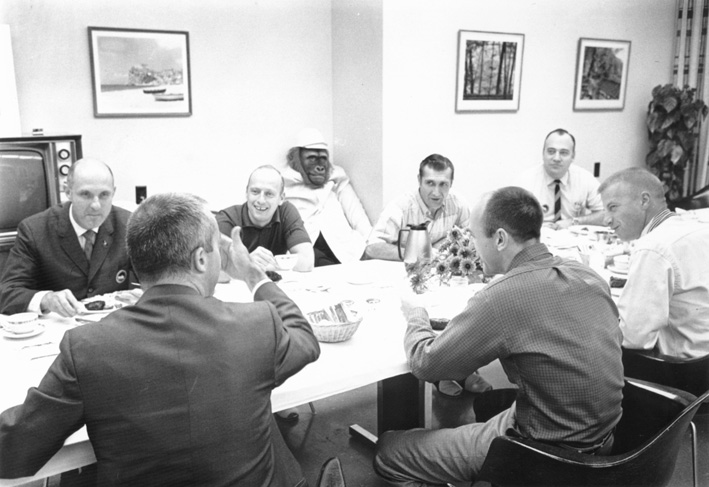
The Apollo 12 crew and guests at breakfast on the morning of launch. Far side: Tom Stafford, Pete Conrad, Dick Gordon, unknown (probably Chuck Tringali). Near side: Jim McDivitt, Allan Bean, Paul Weitz. Note the mascot seated against the far wall.
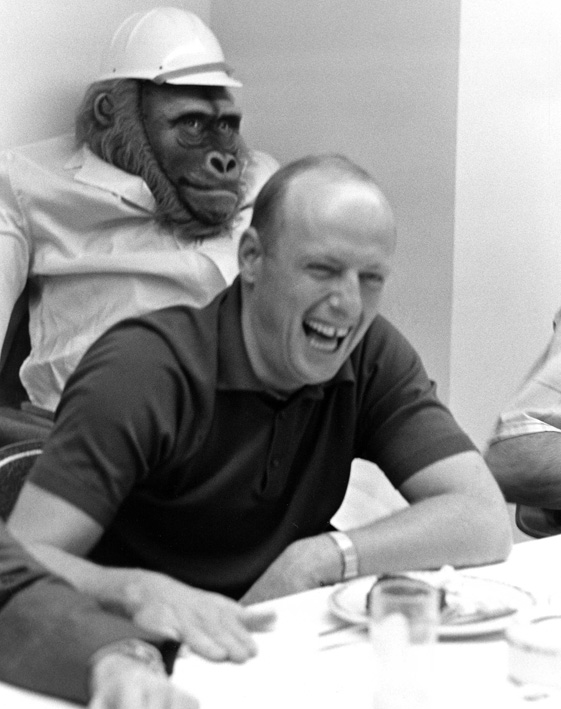
Apollo 12 commander Charles 'Pete' Conrad and mascot during the Apollo 12 prelaunch breakfast.
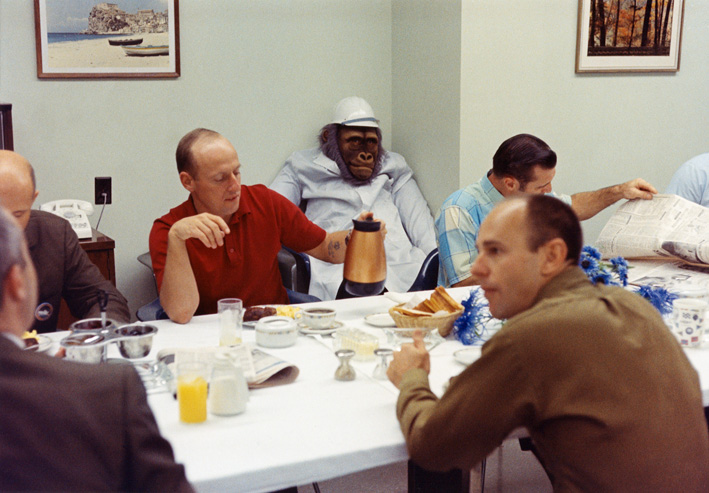
The Apollo 12 crew (with mascot) during their prelaunch breakfast on 14 November 1969.
This is Apollo Saturn Launch Control. T minus 3 hours, 30 minutes in a built-in hold. We’re holding at T minus 3 hours, 30 minutes. We have now been some 28 minutes into this built-in hold. It was declared at 6:52 am Eastern Standard Time, 1 hour duration. All aspects of the countdown for Apollo 12 are still going satisfactorily at this time. The prime crew of astronauts Pete Conrad, Dick Gordon and Alan Bean finishing up breakfast at the crew quarters here at the Kennedy Space Center which is some 8 or 9 miles from the launch pad. The astronauts, just before breakfast, were given a weather briefing and this is the weather status as given to the astronauts by Tom Stafford. The forecast for the local area calls for scattered clouds at an altitude of 2,500 feet [750 metres]. A broken ceiling at 10,000 feet [3,000 metres]. Winds in the Cape Kennedy area will be from the south west, 15 knots with gusts to 25 knots. A temperature of about 67 degrees [Fahrenheit, 19.5°C] is expected at launch time. There can be some remote chance of some sprinkles of rain but that is the forecast as it stands at this time and as far as this forecast is concerned, it is very acceptable for a launch attempt this morning. Elsewhere on the round-the-world track, the weather is acceptable. However we do have a rather extensive frontal area in the extreme Western Atlantic where at its peak, the winds are up to 25 knots with 7-foot [2-metre] seas. The remainder of the Atlantic Ocean track is acceptable also. Pacific also acceptable. In worst cases we do have some winds up to 18 knots with 5-foot [1.5-metre] seas. This is in an area north east of Hawaii. However, despite these high ranges in several locations, it is reported that weather conditions both here at the Cape and around the world track are acceptable for a launch attempt this morning. The propellants are still stable inside the Saturn V space vehicle. We’ll be standing by for the closeout crew to head up to the White Room at the 320-foot [97-metre] level a short time. This will occur while we're still in the hold. In a matter of minutes it is expected that the Apollo 12 crew will go down the hall from their crew quarters to the suit room to don their space suits as they make their final preparations for their departure which should occur some 40 minutes or so - 40 to 45 minutes from this time. We remain in our built-in hold at 3 hours, 30 minutes and holding. This is Kennedy Launch Control.
This is Apollo Saturn Launch Control. We're still in our built-in hold; T minus 3 hours, 30 minutes and holding. We’ll be resuming our countdown at 7:52 am Eastern Standard Time. Prime crew for the Apollo 12 mission, astronauts Pete Conrad, Dick Gordon and Alan Bean, have completed breakfast and have now gone down the hall to the suit room where they will don their space suits and perform final checkouts in preparation for their departure for the launch pad which is due some 40 minutes or so from this time. In the meantime, we’re continuing to monitor the status of the three stages of the Saturn V launch vehicle here in Firing 2 - Firing Room 2 of the Launch Control Center. Both the liquid oxygen and liquid hydrogen supply in the three stages are stable at this time. In the meantime, we’ve now sent the closeout crew down to the launch pad; a team of four men who have taken the elevator up to the 320-foot level and have now reopened the hatch of the Apollo 12 spacecraft. The hatch has been secured since we began the propellant loading back shortly after we resumed our count at the T minus 9-hour mark this morning. At this point, the backup Command Module Pilot, astronaut Alfred Worden, has gone aboard the spacecraft and he will conduct a number of preparatory checks in readiness for the arrival of the launch crew which should come at about - ingress at about T minus 2 hours and 40 minutes in the countdown. Worden is aboard now. He’ll go through some switch list checks and perform some lighting checks - the cabin lighting, and will perform also some Environmental Control System checks in preparation for the arrival of the astronauts. To give a quick rundown once again on the status of the flight crew, they were awakened as planned in the countdown at 6:05 am Eastern Standard Time this morning. This was at T minus 4 hours, 17 minutes in the count. They went down the hall and took a brief a medical exam. Were declared in great shape with everything normal by Dr Alan C. Harter. They then sat down to breakfast. The breakfast was the normal astronaut menu of orange juice, steak, eggs, coffee and toast. The astronauts had five guests for breakfast. They included Tom Stafford who's now chief of the Astronaut Office, who actually awakened the crew this morning; astronaut Jim Irwin who is the backup Lunar Module Pilot; Mr. Chuck Tringali who heads the training team for the Apollo 12 mission as far as the astronaut crew is concerned; Jim McDivitt who is the commander of the Apollo 9 mission but now is Apollo Program Director for the Manned Spacecraft Center; and finally astronaut Paul Weitz. Paul Weitz is the backup - correction, the support Lunar Module Pilot and also acts as Stoney; that's the call sign for the capsule communicator here in the Firing Room during the countdown. Those were the five guests for breakfast. The astronauts now checking out their suits in the suit room at the crew quarters here at the Kennedy Space Center. We are still Go on our countdown at this time. Weather forecast still very acceptable for launch despite a ceiling - a broken ceiling at about 10,000 feet [3,000 metres]. We're still in our hold; 3 hours, 30 minutes and holding; expecting to resume in about 15 minutes from this time. This is Kennedy Launch Control.
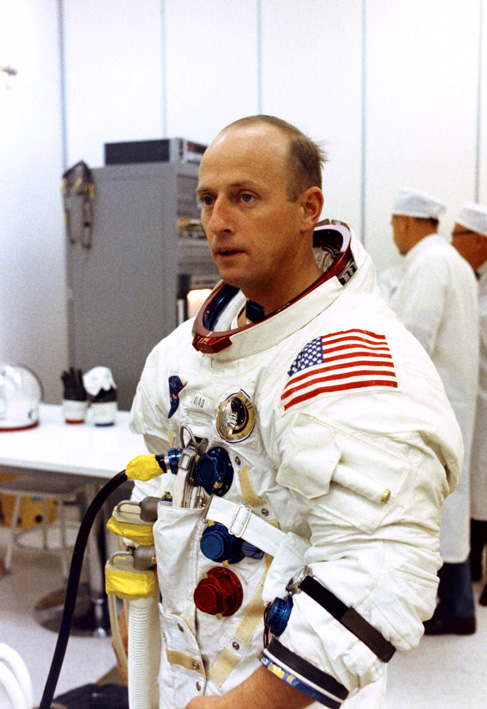
Apollo 12 commander Pete Conrad in the suit room.
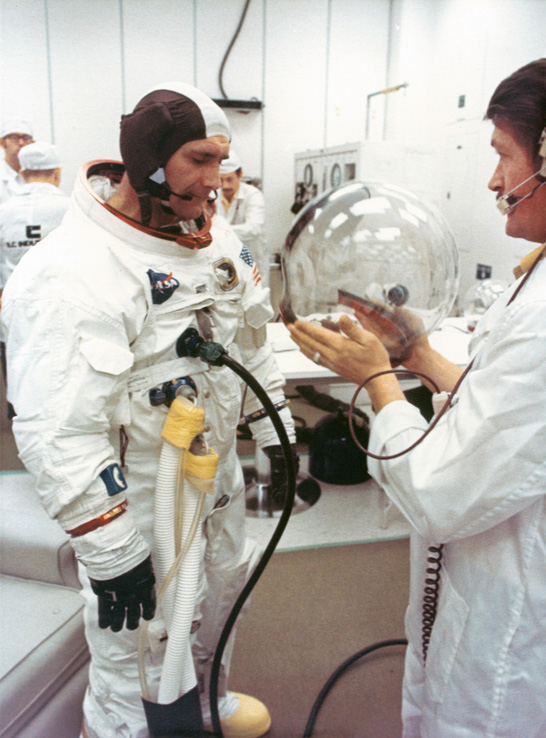
Apollo 12 Command Module Pilot Dick Gordon in the suit room with his helmet.
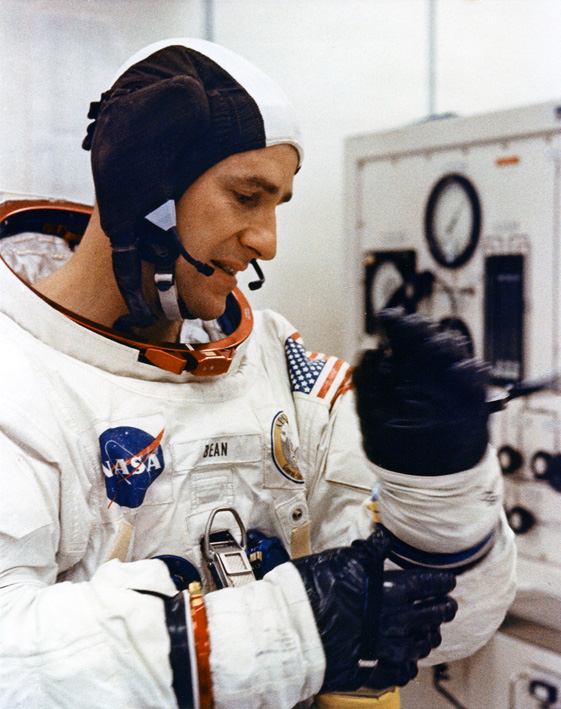
Apollo 12 Lunar Module Pilot Alan Bean in the suit room.
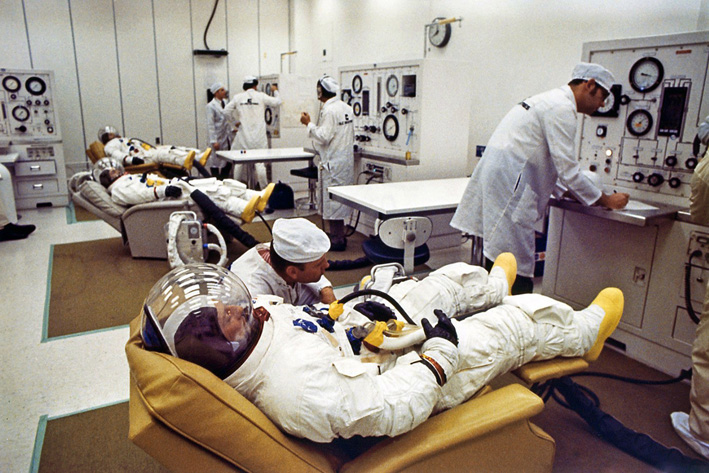
The fully suited Apollo 12 crew in the suit room.
...count. Mark. T minus 3 hours, 30 minutes and counting on the Apollo 12 mission. All Go at this time. We resume the count at 52 minutes past the hour. The Apollo 12 pilots still in the suit room at their crew quarters here at the Kennedy Space Center at this time. We expect them to depart the quarters in about 17 minutes or so on the trip of some 7 or 8 miles to the launch pad. We are Go with our countdown at this time. Now 3 hours, 29 minutes, 30 seconds and counting; this is Launch Control.
This is Apollo Saturn Launch Control; T minus 3 hours, 21 minutes, 26 seconds and counting. We’re on time as far as our count is concerned for Apollo 12. The prime crew for the mission, astronauts Pete Conrad, Dick Gordon and Alan Bean, finishing up their suit checks in the suit room nearby their crew quarters here at the Kennedy Space Center. We expect them to be departing from the crew quarters about 10 minutes from this time to start a trip of about 9 miles that will wind up on the 320-foot level at Complex 39, the location of their Apollo 12 spacecraft. Astronaut Al Worden, the backup Command Module Pilot, is in the Apollo 12 spacecraft at this time busy with preliminary work and preparations checking out the various switches in preparation for the arrival of the flight crew. We are Go at 3 hours, 20 minutes, 37 seconds and counting. This is Launch Control.
This is Apollo Saturn Launch Control. We passed the 3-hour, 18-minute mark in the count. Now 3 hours, 18 minutes - correction 3-hour, 19-minute mark in the count. We’re at 3:18:49 at this time and counting. Still aiming toward our planned lift-off at 11:22 am Eastern Standard Time. The crew now about 7 minutes away from their departure according to the countdown procedures. They’ll leave the crew quarters at about 10 minutes past the hour and take about an 18-minute trip to the launch pad. Right now it appears that we’re having a rainstorm here in the launch pad area. However the weather forecast still stands as acceptable for 11:22 am which is our launch time. Acceptable for launch at that time. We anticipate broken ceiling at about 10,000 feet [3,000 metres], scattered clouds at about 2,500 feet [750 metres]. The winds will be from the south west and they will be acceptable for launch. Al Worden, the backup Command Module Pilot, busy in the spacecraft at this time at the 320-foot level making final preparations for the arrival of the flight crew. Worden’s checkouts include activating the Caution and Warning system of the spacecraft, securing the S-band communication system. He injects some chlorine into the water system, the final fix on the water to adjust it for flight. Other work concerns checking out the suit circuit. This is the direct oxygen feed that goes into the suit circuits of the three suits of the astronauts once they do come aboard. He also checks the lighting in the cabin to assure that it's in a flight mode and remove some of the pyro arm switches in preparation for the astronaut arrival. At the present time, we have four people in the White Room. In addition to Command Module Pilot Worden who is of course the backup Command Module Pilot, we have the pad leader, a Command Module technician and a quality control representative. We will wind up with nine people in the White Room. That is the maximum that will occur once the crew comes aboard since they will be accompanied by two suit technicians when they come up to the 320-foot level. We are standing by from monitoring the status of the count here in the Firing Room 2 at the Launch Control Center and the reports we're getting from Spacecraft Test Conductor Skip Chauvin at the spacecraft checkout facility in the Manned Spacecraft Operations Building, 'All still going well'. We are now at 3 hours, 16 minutes, 26 seconds and counting; this is Kennedy Launch Control.
This is Apollo Saturn Launch Control. 3 hours, 12 minutes and counting. The Apollo 12 crew now departing the crew quarters, boarding their transfer van ready for the 9-mile trip to the launch pad. We give about 18 minutes for the crew to do - go from their crew quarters to the launch pad where they’ll board their Apollo 12 spacecraft at the 320-foot level. We had it logged at 10 minutes past the hour when the Apollo 12 crew members, astronauts Pete Conrad, Dick Gordon and Alan Bean, departed from the quarters and boarded their van. Although it appears not to be raining at the crew quarters area, we appear to have a pretty good rainstorm going on in the vicinity of the launch pad at this time. However it is not interfering with any of our operations in the count. The weather forecast is still Go for launch as far as our 11:22 am Eastern Standard Time T-zero is concerned. The crew now aboard the transfer van. We expect they will be departing shortly for the trip to the pad. The three astronauts are accompanied by two suit technicians and the procedure of boarding the spacecraft will be as follows. The first astronaut aboard will be the commander, astronaut Pete Conrad, who sits in the left-hand seat. He will be followed by the Lunar Module Pilot Alan Bean who sits in the right-hand seat. While these first two crewmen are going aboard, the third member of the crew, astronaut Dick Gordon, will remain in the elevator at the 320-foot level. He will be in the company of a suit technician and as the progress of the second astronaut, Alan Bean, is accomplished as he's brought aboard, Dick Gordon will be called across the swing arm and will be the third member of the crew to come aboard. The transfer van now departing from the crew quarters at the Manned Spacecraft Operations Building here at the Kennedy Space Center on the start of the trip to the launch pad. We’re at 3 hours, 10 minutes, 20 seconds and counting; we’re Go on the Apollo 12 countdown at this time; this is Kennedy Launch Control.
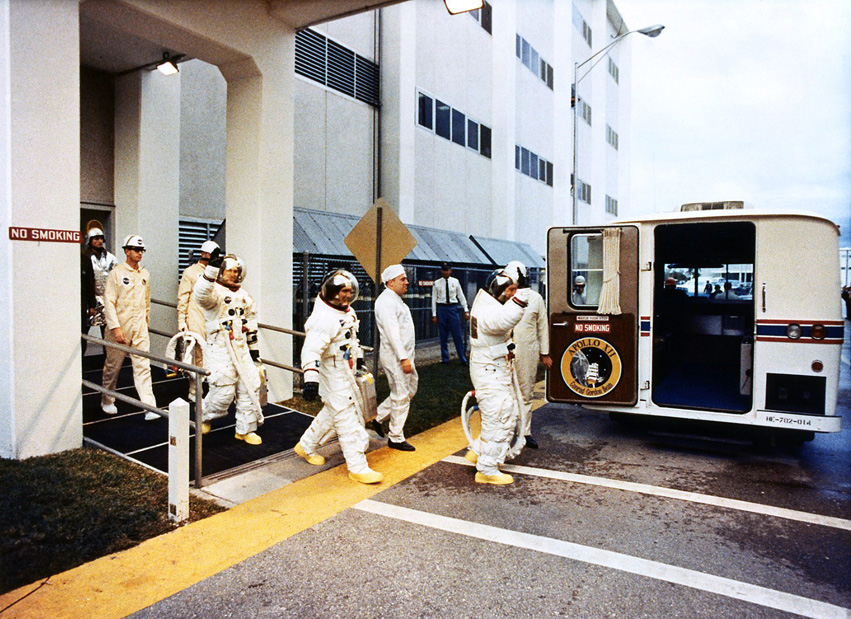
The Apollo 12 crew leave the Manned Spacecraft Operations Building to board the transfer van that will take them to the launch pad. Pete Conrad is at the front, followed by Dick Gordon and Alan Bean.
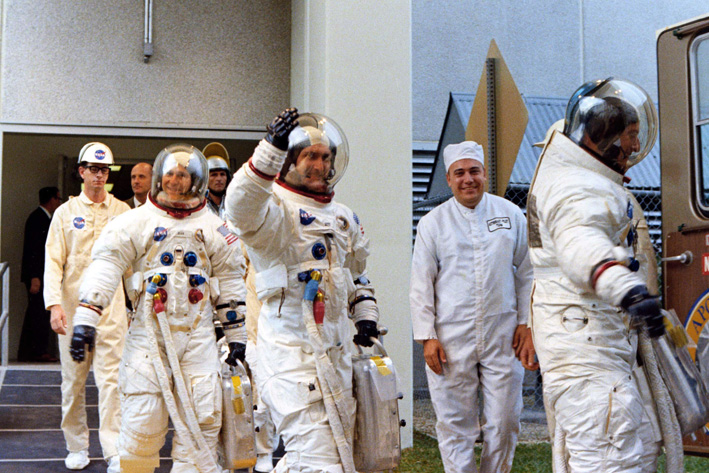
The Apollo 12 crew leave the Manned Spacecraft Operations Building to board the transfer van that will take them to the launch pad. Pete Conrad is at the front, followed by Dick Gordon and Alan Bean.
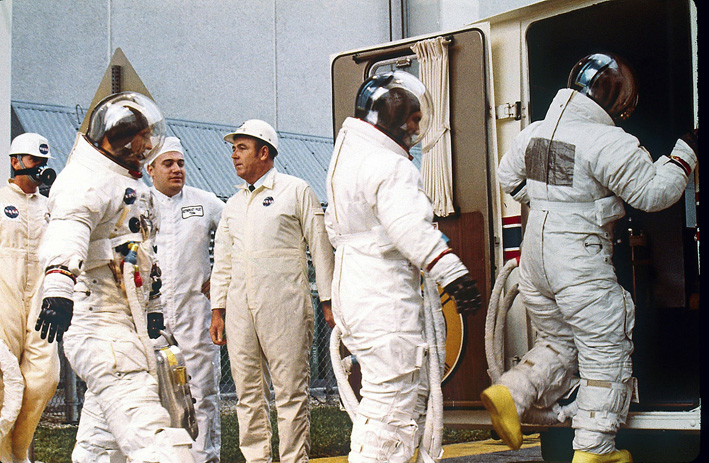
The Apollo 12 crew leave the Manned Spacecraft Operations Building to board the transfer van that will take them to the launch pad. Pete Conrad is at the front, followed by Dick Gordon and Alan Bean.
This is Apollo Saturn Launch Control; T minus 2 hours, 58 minutes, 54 seconds and counting. The Apollo 12 crewmen aboard their transfer van, now going down the last leg on their trip to the launch pad. They're on the main road. Now they’ve gone past the Launch Control Center and are heading down - they’ll be coming up shortly on the Mobile Service Structure park site and then they’ll make the turn toward Pad-A. It's about 18 minutes that we give the transfer van to make the trip from the crew quarters to the launch pad. Once the astronauts do arrive at the pad, they’ll board one elevator that will take them inside the Mobile Launcher and a second high-speed elevator that will take them up the Mobile Service Structure [means Launch Umbilical Tower] to the 320-foot level from where they will board their Apollo 12 spacecraft. The backup Command Module Pilot Al Worden is aboard the spacecraft at this time, as he has been for the last 30 or 40 minutes or so performing final checks of switches and the water and Environmental Control System in preparation for the arrival of the crew. Standing - standing by in the White Room, awaiting the arrival of the astronauts, are the pad leader, a Command Module technician and a quality control representative. We expect the crew to board the spacecraft starting at the 2-hour, 40-minute mark in the count. This is the way it is according to the book which would be some 17 minutes from this time. It could be earlier depending on their arrival. We had some rain in the launch pad area. It’s difficult to tell whether we still - whether it is still raining at this time in the pad area. However the weather forecast still stands as acceptable for our launch attempt at 11:22 am. We’re continuing to monitor the status of the launch vehicle here in the Firing Room at the Launch Control Center. All is well with the countdown at this time. We are Go for Apollo 12. 2 hours, 57 minutes, 3 seconds and counting; this is Launch Control.
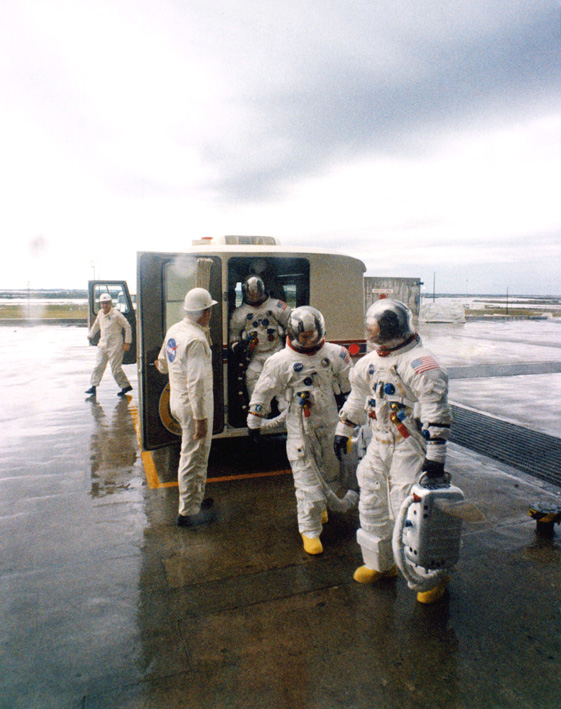
The Apollo 12 crew exit the transfer van at a wet Pad 39-A. Pete Conrad is at the front, followed by Dick Gordon and Alan Bean.
This is Apollo Saturn Launch Control; T minus 2 hours, 53 minutes, 5 seconds and counting. The prime crew for Apollo 12 now has arrived at the launch pad. The three crewmen are aboard the first of two elevators they’ll use to get to the 320-foot level. They’re now joined in the elevators by the two suit technicians. The first elevator will take them to the A-level inside the Mobile Launcher. Once inside, they will walk through the A-level of the Mobile Launcher to catch one of the two high-speed elevators that are located at the A-level. These elevators can travel at 600 feet per minute. They will take the astronauts, all three crewmen, up to the 320-foot level from where Conrad and Bean will cross the swing arm to approach the White Room where their spacecraft is located. The astronauts now going into the A-level of the Mobile Launcher. They step across a bulkhead, walk down a short hall and then aboard a waiting elevator. This elevator is controlled by the capsule communicator here in the Firing Room who is astronaut Paul Weitz for this mission. The astronaut - the 11 - The Apollo 12 astronauts now going down the hall. They’ll board the high-speed elevator and should be up near the spacecraft shortly. 2 hours, 51 minutes, 48 seconds and counting; this is Launch Control.
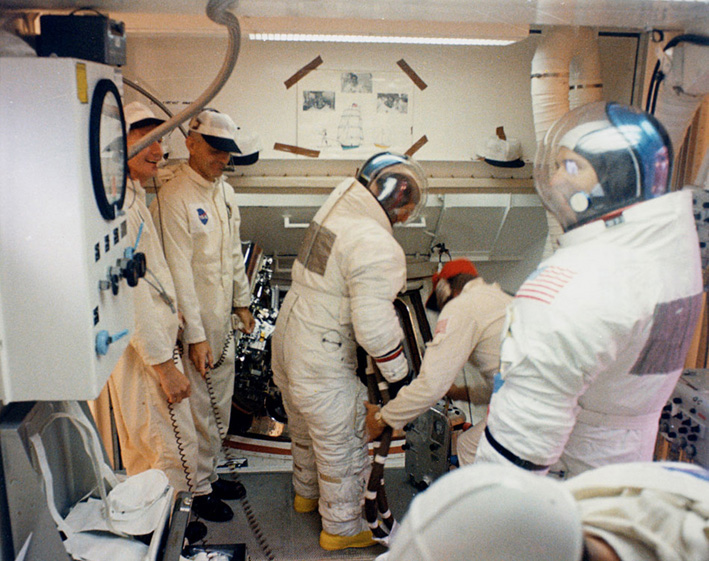
Pete Conrad in the White Room prepares to enter the Apollo 12 spacecraft. Alan Bean is on the right awaiting his turn.
This is Apollo Saturn Launch Control; T minus 2 hours, 48 minutes, 56 seconds and counting. The astronauts have arrived in the White Room. That is the spacecraft commander Pete Conrad and the Lunar Module Pilot Alan Bean. The third member of the crew, astronaut Dick Gordon, will stand by in an elevator located on the Mobile Launcher at the 320-foot level. He is in the company of a suit technician and will be called across the swing arm after his two colleagues go aboard. The spacecraft commander Pete Conrad now boarding the spacecraft. He sits in the left-hand seat. We have him over the sill at 33 minutes past the hour. 8:33 am Eastern Standard Time, and Pete Conrad is aboard the Apollo 12 spacecraft. Astronaut Al Worden, the backup Command Module Pilot, will be a fourth astronaut in the spacecraft for some 30 or 40 minutes. He's inside now and he will give a hand in seating all three astronauts in their couches. Worden will work in the front of the spacecraft, that is, in front of the couches giving a hand while the suit technician works in the rear, that is, behind each couch. So at certain points, we will have actually 5 people in the spacecraft; the three crewmen, the backup Command Module Pilot Al Worden, and just inside the spacecraft, the suit technician. And Worden and the suit technician will give a hand in getting the astronauts seated snugly into their couches and help them with their preliminary checks. Alan Bean, the Lunar Module Pilot, who will sit in the right-hand seat, should be coming across the sill shortly. Dick Gordon, as we reported, still standing by in an elevator on the other side of the Apollo access arm. The Spacecraft Test Conductor has just made a communications check and received a cheery ‘Good morning’; ‘Good morning’ from Pete Conrad, the spacecraft commander. That is our status at this time. We’re 2 hours, 47 minutes and counting. Theoretically some 7 or 8 minutes ahead of the planned procedure time for astronaut ingress. All still going well at this time with Conrad aboard, Bean standing by in the White Room and Dick Gordon still awaiting the call in the elevator at the 320-foot level; this is Launch Control.
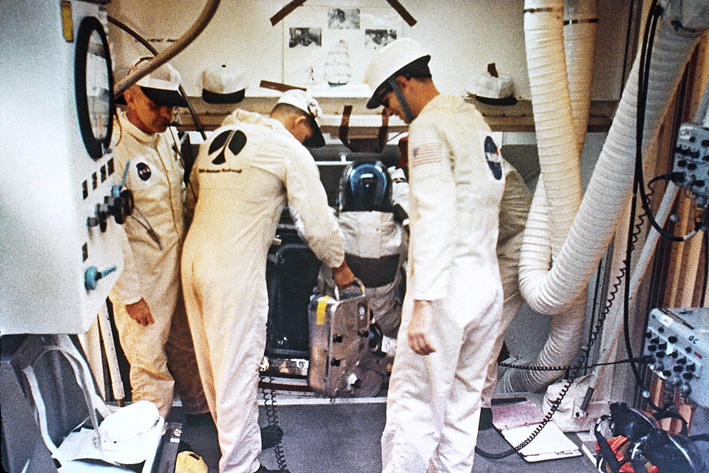
Alan Bean is helped into the Apollo 12 spacecraft by the closeout crew in the White Room.
This is Apollo Saturn Launch Control. the spacecraft commander, astronaut Pete Conrad, now fitted snugly into his couch on the left-hand seat of the Apollo 12 spacecraft and the space - spacesuit technician and backup Command Module Pilot Al Worden now giving astronaut Alan Bean a hand and checking him out. In each case, as an astronaut is brought into the spacecraft, he goes through the same sequence, that is, to hook up the communications cable then actually hook the astronaut and his pressurised garment into the suit circuit system of the spacecraft to bring the oxygen flow to the suit. This is followed by some communications checks and finally we get some preliminary medical readouts on each astronaut and in a final check to assure that everything is okay, the Spacecraft Conduct - Test Conductor in each case asks the astronauts to check some panels nearby to assure that as he came aboard, he might not have inadvertently hit some of the switches. So in each case, we have a switch list check, a brief one. We expect that the Spacecraft Test Conductor Skip Chauvin will be calling the third member of the crew, Dick Gordon, to come across the swing arm shortly. We’ll be standing by. We appear to be right on time as far as our procedures are concerned. Here in the Firing Room, the crew continuing to monitor the status of the Saturn V launch vehicle as we continue with crew ingress. We’re now at 2 hours, 36 minutes, 26 seconds and counting; we are Go for Apollo 12 on our launch attempt with the window starting - the window opening at 11:22 am Eastern Standard Time. This is Kennedy Launch Control.
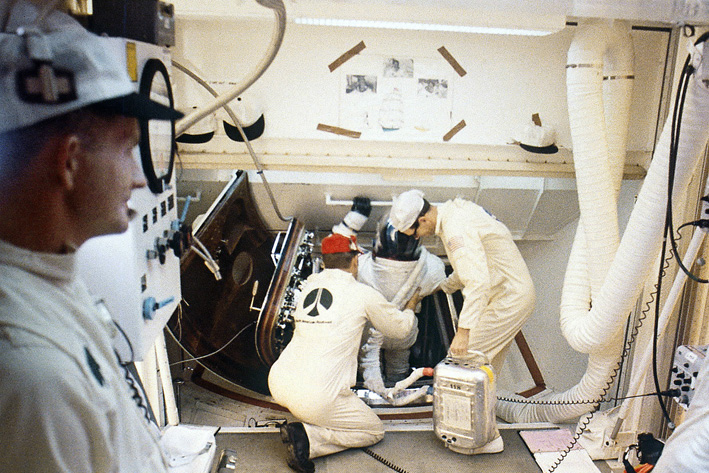
Dick Gordon is aided from the White Room toward the centre couch of the Apollo 12 spacecraft.
This is Apollo Saturn Launch Control; T minus 2 hours, 28 minutes, 55 seconds and counting. Still Go with Apollo 12 at this time. At the 320-foot level at Launch Pad A, where the hatch for the Apollo 12 spacecraft is located, we now have the third member of the crew aboard. Dick Gordon, the Command Module Pilot who sits in the middle seat of the spacecraft came aboard the spacecraft at 46 minutes past the hour. We boarded all three astronauts in the span of about 13 minutes. At this time, the Spacecraft Test Conductor talking with the crew in the White Room and aboard the spacecraft, going through the final checks of getting astronaut Dick Gordon aboard, getting him checked into the couch, tied into the suit circuit system, having him check a few switches to ensure he did not bump any on the ingress activity. We still have the suit technician in the spacecraft. And in front, in the Lower Equipment Bay is Al Worden also giving a hand as we go through the preliminary checkout of the three pilots aboard. We’ll make a - get a quick medical read out here shortly on Dick Gordon and then Houston Flight, Mission Control Center, Houston, is standing by to perform some communication checks with the astronauts aboard the spacecraft. All still going well with the count. Weather is Go and we're still aiming toward our planned T-zero at 11:22 am Eastern Standard Time. 2 hours, 27 minutes, 29 seconds and counting; this is Kennedy Launch Control.
This is Apollo Saturn Launch Control; T minus 2 hours, 18 minutes, 35 seconds and counting. Still proceeding on schedule; in fact a few minutes ahead of schedule in our preparations for the launch of Apollo 12. Our checkout in the spacecraft - Command Module going well at 320-foot level. We've just had Al Worden, who was for a while the fourth astronaut aboard the spacecraft, he has just come out after giving the three prime pilots a hand on their preliminary checkouts. We’ll be ready in a short while here, perhaps a little ahead of time, to close the hatch and will be coming up with some more command checks from the Mission Control Center in Houston. These are checks in which Houston can send commands to the spacecraft and the astronauts confirm that these commands have been received and actually accepted by the spacecraft computer. This is a requirement, of course, for launch that following lift-off, if necessary, direct commands could be sent from the ground to update the spacecraft computer. Our countdown still going normally here in Firing Room 2. The crew continuing to monitor the overall status of the Saturn V launch vehicle, keeping a close eye on the various propellants aboard and all our propellants are stable as the countdown continues. All still going well. The pad leader has just reported that he's ready to close the hatch and it looks like hatch closure is coming up in a matter of seconds. The hatch being closed now at about 5 minutes past the hour. We seem to be progressing very well in our work up there at the 320-foot level with the three astronauts and their preliminary checkouts aboard Apollo 12. 2 hours, 16 minutes, 57 seconds and counting; we are still Go on Apollo 12. This is Kennedy Launch Control.
This is Apollo Saturn Launch Control; T minus 2 hours, 6 minutes, 40 seconds and counting. We’re still proceeding on time and, in fact, a little bit ahead of the count as far as our procedures are concerned. The spacecraft commander, astronaut Pete Conrad, has just completed some busy work concerned with the abort advisory system. This is a series of cue lights on a panel in front of him that would indicate a difficulty or problem requiring an abort during the early phases of flight. We checked out this system, working with the Launch Operations Manager Paul Donnelly here in the Firing Room, who has the capability of recommending an abort. Also tests were accomplished by the Spacecraft Test Conductor, Houston Flight. And those are the three; the Spacecraft Test Conductor, Launch Operations Manager and Houston Flight. They sent their abort recommendations and Conrad confirms that he did in fact receive the abort light indications during this test. Coming up next will be a bit of a milestone as far as the spacecraft checkout is concerned. This is the Emergency Detection System check, the EDS checks they're called. This is an exercise with Pete Conrad working with both the spacecraft and launch vehicle crew to give a complete check out of the Emergency Detection System. We check all the various modes of the EDS to assure that the astronauts would get their proper cues aboard the spacecraft in the event anything went wrong down below. All the various abort modes are exercised and the various abort recommendations come to Conrad. This is a test of about 30 minutes duration. Pete Conrad is now getting his panels ready for this test and we expect to beginning it shortly. All other aspects of the count going well. Our weather forecast still stands; broken ceiling at about 10,000 feet [3,000 metres], scattered clouds about 2,500 feet [750 metres], temperature in the launch area about 67 degrees [Fahrenheit, 19.5°C]. The weather conditions are acceptable for a launch attempt this morning. Still Go on Apollo 12. T minus 2 hours, 4 minutes, 37 seconds and counting; this is Launch Control.
This is Apollo Saturn Launch Control; T minus 1 hour, 58 minutes, 56 seconds and counting; still Go on Apollo 12 at this time. The crew still working aboard the spacecraft with the hatch closed, and the support team in the White Room area at the 320-foot level now proceeding to start the cabin purge and leak checks. What is accomplished during this period, of course, is once spacecraft hatch is closed, we want to bring aboard into the cabin the 60/40 per cent atmosphere of oxygen and nitrogen. This is the atmosphere that we fly with at lift-off inside the cabin. Of course, the three astronauts themselves are on their suit circuit and breathing 100 per cent oxygen through that circuit. The cabin purge is going on at this time, and we will be keeping an eye on it to assure that we have reached the proper adjustments inside the cabin. Once that is completed, we’ll perform some leak checks to assure that we are stable inside the cabin. Astronaut Pete Conrad will be busy working on the Emergency Detection System test, talking with both launch vehicle and spacecraft checkout personnel as the EDS test, overall check of the Emergency Detection System, continues. As reported, this is a rather lengthy test in our countdown, lasting some 30 minutes or so. We're still going well, aiming toward our planned lift-off at 11:22 am Eastern Standard Time. This is Kennedy Launch Control; T minus 1 hour, 57 minutes, 27 seconds and counting.
This is Apollo Saturn Launch Control at T minus 1 hour, 48 minutes, 55 seconds and counting. We are still Go with our countdown for Apollo 12 at this time, aiming toward our planned T-zero of 11:22 am Eastern Standard Time. The spacecraft commander, astronaut Pete Conrad, still busy aboard the Apollo 12 spacecraft, going through the final checks of the various modes of the Emergency Detection System of the space vehicle. The other astronauts are keeping an eye on activities inside the cabin as we continue our purge and leak checks. That is bringing the cabin atmosphere to the 60-40 oxygen-nitrogen atmosphere that we desire for lift-off. The astronauts are breathing of course 100 per cent oxygen through their suit circuits. Our countdown picked up at the T minus 9-hour mark at 1:22 am Eastern this morning, and we then proceeded here in the Firing Room to begin the final propellant loading of the Saturn V launch vehicle. As it stood on the pad at that time, it already had its RP-1 fuel aboard the first stage. However, we spent 4½ hours or so bringing in more than three quarters of a million gallons [2,800,000 litres] of the cryogenic propellants, the liquid oxygen and liquid hydrogen. We started loading oxygen to all three stages from the top down, and then went into the final phase of the propellant loading, bringing the hydrogen fuel first aboard the second stage and finally aboard the S-IVB third stage. All of this work was accomplished by the time we went into our planned built-in hold at T minus 3 hours and 30 minutes. As far as the prime crew is concerned, after a good 8 hours of sleep, they were awakened in the crew quarters by astronaut and Chief of the Astronaut Office, Tom Stafford, at 6:05 am Eastern this morning. The crew then went down the hall to take their customary brief medical exam on launch morning; they were examined by doctors Alan C. Harter and John T. Teegan. Following the brief examination Dr. Harter declared the astronauts were in great shape and that everything is normal. The crew then received a weather briefing from Tom Stafford; his briefing still stands at this time as far as the weather forecast is concerned. The astronauts were told that they would expect the following conditions at launch time; scattered clouds in the Cape Kennedy area of about 2,500 feet [750 metres], a broken ceiling at about 10,000 feet [3,000 metres], we'd have winds from the south west about 15 knots with gusts to 25 knots, a temperature in the launch area of 67 degrees [Fahrenheit, 19.5°C]. All of these conditions are acceptable for a launch attempt. Weather on the round-the-world track in some places a little rough; in the Western Atlantic, particularly; we have 7-foot [2-metre] seas, and winds up to 25 knots. However, looking at all the abort contingency areas, weather is acceptable in those areas also, for a flight attempt this morning. The astronauts sat down to the normal breakfast menu of steak, eggs, orange juice, coffee and toast. They had 5 guests for breakfast. The guests included Tom Stafford, the backup lunar module pilot, astronaut Jim Irwin, Jim McDivitt, who is the Apollo Program Manager at the Manned Spacecraft Center, astronaut Paul Weitz and Paul Weitz is the support Lunar Module Pilot for the Apollo 12 mission, and also sits in as the Capsule Communicator with the call sign 'Stoney' here in the Firing Room. The fifth man to join the group was Mr. Chuck Tringali, Mr. Tringali is head of the support training group for the Apollo 12 crew. A sixth individual in the room was a life size gorilla from what we understand - a stuffed gorilla - that was sent to Pete Conrad by one of his friends. This gorilla had been adopted as a mascot by the crew and he was rigged up in a flight smock and a crash helmet seated on the side in the - in the breakfast room when the crew came in. The crew then departed the quarters after donning and checking out their space suits at the appointed time, 8:10 am Eastern Standard Time, and proceeded to the launch pad, up to the 310-foot level where in order, they boarded the spacecraft follows: First the commander Pete Conrad, who sits in the left hand seat, followed about 6 minutes later by astronaut Alan Bean, the Lunar Module Pilot in the right hand seat, and another 7 minutes went by and then Dick Gordon, the final member of the crew came aboard, the Command Module Pilot who sits in the middle seat. The hatch was then closed, and the countdown is proceeding satisfactorily since that time. We're at 1 hour, 44 minutes and counting; this is Kennedy Launch Control.
This is Apollo Saturn Launch Control; T minus 1 hour, 38 minutes, 55 seconds and counting. Countdown's still progressing satisfactorily at this time. We've completed that rather extensive Emergency Detection System checks with astronaut Pete Conrad working the various checkouts with the Launch Vehicle and Spacecraft crews here at KSC. We've gone through all the various abort modes that could signal trouble to the astronauts on top of the Saturn V, and we are now assured that that system is performing satisfactorily. In the meantime, we have completed the purge of the spacecraft cabin and have completed our leak checks. We know now that the cabin is on the 60 per cent oxygen, 40 perc ent nitrogen environment that we want for lift-off. Once again, of course, the astronauts inside their suits on the spacecraft suit circuit are breathing 100 per cent oxygen, but the cabin atmosphere itself is the 60-40 combination. All still going well. One hour, 37 minutes, 58 seconds and counting; this is launch control.
This is Apollo Saturn Launch Control; T minus 1 hour, 28 minutes, 55 seconds and counting; we are proceeding with the Apollo 12 countdown at this time, still aiming at our planned T zero of 11:22 am Eastern Standard Time. At this point in the countdown, the closeout crew at the 320-foot level at launch Pad A now proceeding to break up the White Room area. This is the area at the end of that Apollo access arm Number 9, the arm that the astronauts use to go across from the Mobile Launcher to board their spacecraft a while ago. The spacecraft hatch has been closed, the cabin is now at its proper atmosphere. The astronauts have completed several vital tests already, one of them being the Emergency Detection System checks. These were performed by the spacecraft commander, astronaut Pete Conrad, working with the launch vehicle and spacecraft teams here at KSC. This was an extensive checkout of the entire detection system that would inform the astronauts of any abort conditions during the powered phase of flight. Pete Conrad now gearing up for a special check that will occur shortly. This is a calibration of what we call the Q ball. It's an angle of attack meter located atop the emergency escape tower which is located, of course, on top of the Command Module. This angle of attack meter does give read-outs to the flight computer during the powered phase of flight and Conrad is expected to work adjustments with the launch crew to calibrate that instrument shortly. Our weather conditions still stand. Our forecast is still Go for launch. We expect winds from the south west getting up to gusts in the area of some 25 knots, a ceiling of about 10,000 feet [3,000 metres] broken as forecast, however, we are keeping a close eye on this weather front that is in the area. We are Go for launch at this time, however. The astronauts have been up since 6:05 am this morning. They're up now, coming up on about 4 hours and have been working hard in the spacecraft on the final checkouts since they came aboard about 8:30 am, a little bit after 8:30 am this morning. Once the checkout crew has completed their work up there on the swing arm, we will be ready to bring that swing arm back to a standby position, that is remove it from the spacecraft. This is due to occur according to the procedures at the 43-minute mark in the countdown. All is still going well with our count still a little bit of ahead of the time, in fact, on the spacecraft checks as the countdown proceeds for Apollo 12. We are Go at 1 hour, 26 minutes, 16 seconds and counting; this is Kennedy Launch Control.
This is Apollo Saturn Launch Control; T minus 1 hour, 19 minutes, 55 seconds and counting; still proceeding with the Apollo 12 countdown; on time at this time. We're aiming toward our projected T zero at 11:22 am Eastern Standard Time. Astronaut Pete Conrad, the spacecraft commander, is now working with the Spacecraft Test Conductor Skip Chauvin in preparation for some guidance and control checks that will be coming up in the spacecraft shortly. This is where Conrad checks out the various systems used to fly the spacecraft in the space environment. He checks out that big engine below them on the Service Module to make sure that it will gimbal, that is swing in response to commands either from the automatic guidance system aboard the spacecraft or manually by the commander himself if required. He has his translational and rotational hand controllers that he uses in these various maneuvers, and he will be exercising these shortly. We are keeping a close watch now on a weather front that is coming in toward us from the northwest. The Launch Operations Manager Paul Donnelly, just a short time ago, did advise Conrad that we're keeping a close eye on it. This weather front does have some heavy rain and a little bit of lightning has been noted. An estimate could be that we might get it in this area about noon time. Launch Operations Manager Donnelly informed Pete Conrad we hope to have them off in time and in time to avoid any difficulties with weather. Our forecast of a ceiling of 10,000 feet [3,000 metres] broken still stands for the lift-off time, but we're keeping a close eye at this point. T minus 1 hours, 18 minutes, 14 seconds and counting; this is Launch Control.
This is Apollo Saturn Launch Control at T minus 1 hour, 8 minutes, 55 seconds and counting; still Go with Apollo 12 at this time. The spacecraft commander Pete Conrad completing his guidance and control checks, working with the Spacecraft Test Conductor here at KSC. The G&C checks, Guidance and Control checks of the spacecraft, still appear to be going well at this time. We are keeping a close eye on this weather front that's north west of us. The forecast now is that there could be a very good possibility of having rain in the launch area at launch time. We'll continue to keep a close eye on the status of this weather front to determine whether it will interfere with our launch plan. Right now we are still counting and we're still aiming toward our planned T zero at 11:22 am Eastern Standard Time. 1 hour, 8 minutes, 6 seconds and counting; this is Launch Control.
This is Apollo Saturn Launch Control at 58 minutes, 56 seconds, and counting. We're into the last hour of the Apollo 12 countdown, and with the exception of that weather front that we're keeping a close eye on, all still going well with the countdown. The crew at the 320-foot level is ready to depart from the White Room on call. They've performed all their final checks. In the meantime, here in the Firing Room, we've completed some of the launch vehicle final telemetry checks, and astronaut Pete Conrad still working with Spacecraft Test Conductor Skip Chauvin on the final guidance and control checks. These are final refinements of the instrumentation used for that Stabilization and Control System and the Guidance and Navigation system that is vital during the time of flight that the astronauts are in space and, of course, in lunar orbit. Our testing is going well. We understand that the rain line on this weather front is probably about 8 miles west of us, and we're just going to keep a close eye on it as the countdown proceeds. In the meantime, the Vice President of the United States now has arrived in the Firing Room, and we understand the President of the United States, Air Force 1, his aircraft is now in the area, and the President is expected to land shortly. Our countdown still proceeding. We're still aiming toward 11:22 am keeping a close eye over our shoulder to the northwest for that weather front to see whether it will have any effect on our launch attempt here at the opening of the window. We're now at T minus 57 minutes, 22 seconds and counting; this is Launch Control.
This is Apollo Saturn Launch Control. We just passed the 49-minute mark in our countdown. We are now T minus 48 minutes and 53 seconds and counting. The count is going well, but the weather appears to be deteriorating. However, we are still counting. The front that has been north west of us appears to be coming in. We'll be standing by. The Launch Director Walt Kapryan is getting direct reports on the weather, and if any determination is made, it will be announced immediately. In the meantime, we are still counting at this time. Pete Conrad has completed his guidance and control checks in the spacecraft and made some verifications of the Entry Monitoring System, one of the systems that would be used on re-entry either from an abort condition or the normal re-entry from their flight to the Moon and back some 10 days after lift-off. We'll be keeping a close eye on the weather as the countdown proceeds. Coming up on the 48-minute mark now. We have a report that the President of the United States has arrived aboard Air Force 1 at Patrick Air Force Base, coming off the plane at about 10:29 am Eastern Standard Time, and is on his way with Mrs. Nixon via helicopter to the Kennedy Space Center. We'll be standing by, particularly keeping a close watch on the weather. As far as the count is concerned, the Apollo 12 spacecraft and that Saturn V launch vehicle at Pad A, all still going well at this time. 47 minutes, 30 seconds and counting; this is Launch Control.
This is Apollo Saturn Launch Control. T minus 43 minutes, 56 seconds and counting. The Launch Director still receiving advisories at this time on the weather status. We expect determination to be made shortly on what our plan will be. One possibility will be, if required, to hold the countdown at the 24-minute mark but this exact determination has not been made; repeat, has not been made at this time. As far as the status of the Apollo 12 astronauts are concerned, that determination also will be made if a hold is required, whether or not the crew will remain on board. We'll stand by for these decisions and as soon as these are made, they will be passed on to you. We are standing by at this time. The count still going at this point and all still well with all technical phases of the count. 43 minutes, 6 seconds and counting; this is Kennedy Launch Control.
This is Apollo Saturn Launch Control; T minus 38 minutes, 56 seconds and counting. Still proceeding, the countdown clock going at this time. Our weather conditions are just about the same. Basically, we're in a touch and go condition at this time, standing by for continuing reports on the progress of this weather front and how it's going to affect us about 35 minutes from now - or 38 minutes from now, at the projected T zero time of 11:22 am Eastern Standard Time. If a hold is necessary, it will be declared, perhaps about the 24-minute mark. However, we are going to keep an eye on it as the countdown continues. It appears that if the - we do have to hold for this front, the time element would be such that it's possible the Apollo 12 crew may elect to remain in the spacecraft. Obviously if the front was more severe, with lightning involved, the crew would be removed. No decision has been made on this at this time, and this matter is still up in the air at this time, because the clock is still moving and we are still standing by for further reports. We're 37 minutes, 50 seconds, and counting; this is Launch Control.
This is Apollo Saturn Launch Control. We've just passed the 30-minute mark in our countdown. We're now at T minus 29 minutes, 54 seconds and counting. The countdown for Apollo 12 still going at this time. Project officials are still keeping a close eye on this weather front that has moved into the area more rapidly than anticipated earlier this morning. The weather front actually speeded up a little later in the morning. A determination has been made to continue this countdown at least down to the 10-minute mark in the count. We'll be getting recurring reports on weather conditions as we continue and determinations will be made. We will count at least to the 10-inute mark and either hold at that point, or if conditions are such, continue, still aiming toward our planned lift-off at 11:22 am Eastern Standard Time. The Apollo 12 crew of astronauts Pete Conrad, Dick Gordon, and Alan Bean aboard the Apollo 12 spacecraft up there at the 320-foot level of the pad have been informed of this decision, and they are in accord and our countdown continues. The Apollo access arm, swing arm number 9 that up to this time has been attached to the spacecraft, now has been moved to its standby position some 12 degrees or 6 feet [1.8 metres] from the spacecraft. In the event that we had an emergency egress situation, this swing arm could be brought back rapidly so that the astronauts could depart. Our countdown is continuing at this time, and we are standing by, keeping a close watch on weather conditions. T minus 28 minutes, 25 seconds and counting; this is Kennedy Launch Control.
This is Apollo Saturn Launch Control. We've passed the 24-minute mark in our countdown, now T minus 23 minutes, 53 seconds and counting. Still counting at this time. All aspects of the flight, with the exception of weather, looking very good. We have no problems other than this weather front that is upon us. The countdown continuing; we will count, if we can, down to the 10-minute mark at least where a final determination will be made. At this time in the spacecraft at the 320-foot level, the Command Module Pilot, astronaut Dick Gordon, sitting in the middle seat, completing some final checks of the Reaction Control System of the spacecraft. These are those thrusters that are used to enable the spacecraft to maneuver in space. We pressurize the propellants prior to launch to assure that they will work properly when required on the flight to the Moon. In the meantime, with the launch vehicle, we've made some final checks of the range safety command destruct system. These are the destruct packages aboard the rocket that if the vehicle did fly off trajectory and became a danger to land areas, the vehicle could be destroyed. Of course, this would occur after the astronauts were safely separated from the faulty launch vehicle, using that escape tower atop the vehicle. That escape tower also has been armed at this time. Our countdown still continuing, weather reports still coming in. 22 minutes, 30 seconds and counting; this is Kennedy Launch Control.
This is Apollo Saturn Launch Control; T minus 18 minutes, 40 seconds and counting. Countdown still proceeding at this time although it is touch and go at this time. We are still not below our minimum margins for launch. The countdown proceeding as reported earlier. We do plan to count down to the 10-minute mark unless we get information prior to that time that would show us we could not go. Out at the spacecraft, commander Pete Conrad still appears to be very cheerful in the spacecraft as he reports back on the settings, the final settings of the Stabilization and Control System switches. These are the switch panels concerned with the propulsion system that is used in orbit and of course on the way to the Moon for spacecraft maneuvers once our Saturn V launch vehicle has placed the spacecraft on its proper trajectory. We are conditioning the tanks of the third stage of the Saturn V launch vehicle with some super cold helium to prepare it for engine ignition, which of course would occur during the powered phase of flight. Since that liquid hydrogen fuel must be maintained at 423 degrees [Fahrenheit] below zero [-273°C, 20K], we want to introduce a cold atmosphere to the tank itself and the engine chamber so that that ignition will be proper when it occurs during the powered flight. Although we are looking a little bad outside here at the present time, our countdown is still proceeding. We're giving reports to the astronauts on our status. They are performing their normal functions at this time as the countdown continues. Coming up in several minutes, the spacecraft will go on full internal power with the fuel cells. We're now coming up on the 17-minute mark. Mark. T minus 17 minutes and counting on Apollo 12.
This is Apollo Saturn Launch Control; T minus 14 minutes, 16 seconds and counting. We are Go on Apollo 12; we are aiming toward our planned lift-off at 11:22 am Eastern Standard Time. The countdown will continue; our latest weather advisories are such that conditions are predicted to be acceptable for a launch attempt at 11:22 am. Although we do have rain in the area, our minimums are acceptable. The top of this weather front is at about 23,000 feet [7,000 metres], and we have confirmation of very low turbulence concerned with this front. All of these matters related with many other determinations concerned with our mission rules, the Launch Director Walt Kapryan has given a Go to continue the count. The astronauts have been given this word; they're busy in the spacecraft at this time, because the spacecraft has just gone on full internal power with the fuel cells. Up to this time we have been sharing the load of the power of the spacecraft with the - an external power source. The astronauts also are making their final read-outs on the Stabilization and Control System with Pete Conrad reporting back to the Spacecraft Test Conductor Skip Chauvin. The astronauts will arm their rotational hand controllers, those hand controllers that are used to perform the various maneuvers in space, as the countdown continues. We'll be coming up shortly with some command signals from Mission Control in Houston, to assure that Houston will be able to send proper commands to the spacecraft once we have lift-off. Our countdown is proceeding; 12 minutes, 42 seconds and counting. This is Kennedy Launch Control.
This is Apollo Saturn Launch Control. We've just passed the 9-minute mark in our countdown, T minus 8 minutes, 54 seconds and counting. Right at this point, astronaut Tom Stafford, here in the Firing Room, is talking with Pete Conrad bringing him up to date on the weather conditions. The weather conditions as reported on the last announcement, that is, we have a top of this weather front of about 23,000 feet [7,000 metres], a very low turbulence associated with it. Pete Conrad has just reported back, sounds good to him. Our count still proceeding at this time as Pete Conrad reports back to Tom Stafford. At this point also, Alan Bean, the Lunar Module Pilot in the right-hand seat, has given some up to date read-outs on the status of our fuel cells, the power system for the spacecraft, and they've been recorded by the spacecraft check-out personnel. We've taken a look at the Lunar Module for about 20 minutes. We powered it up at the T minus 30-minute mark in the count. Powered up all systems with the 4 batteries in the descent stage and the two batteries in the ascent stage. The Lunar Module, of course, which will have the call sign
Intrepid when it separates from the Command Module in flight,
Intrepid is Go at this time, and we're now powering down the instrumentation. Spacecraft Test Conductor Skip Chauvin now performing a status check, so are the personnel in the spacecraft control room. All report Go at this time, and the spacecraft ready light should be coming up shortly. We are still Go at this time, 7 minutes, 30 seconds and counting. This is Kennedy Launch Control.
This is Apollo Saturn Launch Control; T minus 6 minutes, 30 seconds and counting. We're still proceeding satisfactorily with our countdown at this time. The Emergency Detection System, that can warn the astronauts of difficulties during the powered flight, now has gone on its automatic sequence. We have power On with the EDS as the countdown continues. The spacecraft ready light is On. The EDS light is On meaning the Emergency Detection System also is Go as the countdown continues. The astronauts now standing by in the spacecraft. Coming up shortly will be some status checks here in the Firing Room. This is Kennedy Launch Control; still go with Apollo 12 at 5 minutes, 52 seconds and counting.
This is Apollo Saturn Launch Control; T minus 5 minutes and counting. T minus 5, that swing arm number 9 will now be coming back to its fully retracted position at the pad. Mark. The swing arm now moving back from the spacecraft as planned at the 5-minute mark in the count. Just before coming up on the swing arm removal, we went through our final status checks and received a loud and strong Go from the Mission Director Chet Lee, Launch Operations Manager Paul Donnelly, and Launch Director Walt Kapryan responding to the request from the Test Supervisor. The lights now will be coming on, on the abort panels of astronaut Pete Conrad. These are his cue lights for the five engines in the first stage. These five lights remain on. When we get proper thrust for lift-off, the lights go out, informing the spacecraft commander that he has good thrust beneath him. We're coming up now on the 4-minute mark. Pete Conrad reports his lights are on. Spacecraft Test Conductor Skip Chauvin has said, 'Have a good trip, Pete.' Pete reported back, 'We appreciate everything everyone has done.' Four minutes and counting. Still proceeding at this time. We'll be coming up on our automatic sequence at 3 minutes and 10 seconds in the countdown. We're going through our final Astro Launch checks at this time as the countdown continues. During these checks just now, the Launch Operations Manager Paul Donnelly said to Pete Conrad, 'The launch team wishes you good luck. May the wind be always behind you.' Pete Conrad said, 'Thank you very much.' Count still continuing. Final checks of the Guidance and Navigation system going on now. Pete Conrad reporting back on their status. We'll be coming up on the automatic sequence in about 10 seconds. From that time on down, we're completely automatic, leading up to 8.9 - the 8.9-second mark in the count when we get the ignition sequence. Mark. Firing command, launch sequence start. We have the firing command. We're on automatic sequence. T minus 3 minutes and counting, T minus 3. Once the automatic sequence began, we begin pressurizing those big fuel and oxidizer tanks, the overall propellant tanks in the 3 stages of the Saturn V launch vehicle. This will lead us up to 8.9 seconds when the engine ignition sequence begins. The five engines in the first stage will ignite, building up 7.6 million pounds thrust total. This should occur at the zero mark in the count. We will get verification through the computer that we have proper start thrust, the hold down arms will release, and we'll be off with Apollo 12.
Two minutes, 20 seconds and counting at this time. Two minutes, 10 seconds at this time. We see that the stages are now beginning to pressurize as our countdown proceeds.
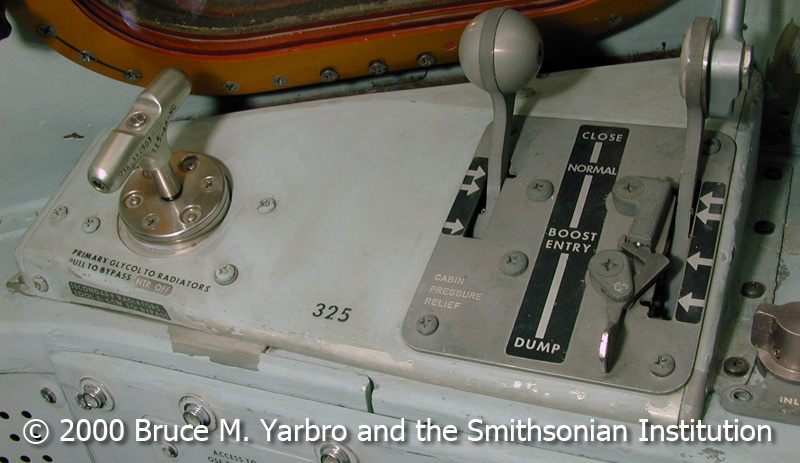
The handle for bypassing the spacecraft's radiators is on the left of this image taken within Odyssey's cabin.
Coming up on the 2-minute mark in the count. T minus 2 minutes and counting, T minus 2. Spacecraft commander now has placed the Environmental Control System of the spacecraft on internal. Up to this time, we've been providing external sources for the Environmental Control System. We're checking the hydraulics of the first stage of the launch vehicle now. We are still Go. One minute, 40 seconds and counting at this time. T minus 90 seconds and counting, T minus 90, still Go. Our status board here in Firing Room 2 indicates all is still well with the countdown. Third stage tanks now pressurized as the automatic sequence continues.
One minute, 15 seconds and counting. Astronaut Alan Bean has just brought the Entry batteries on the main power source in the spacecraft. We've conserved those batteries up to this time. We're coming up on 60 seconds. Mark; T minus 60 seconds and counting. T minus 60. Alan Bean running up the volume on his VHF. 50 seconds and counting. 50. We've now gone internal power with the launch vehicle. We are on the internal batteries in the 3 stages of the Saturn V. T minus 40 seconds and counting. The spacecraft commander now performing his final function, pressing the button to align the guidance and control system of the spacecraft.
Coming up on 30. Mark, T minus 30 seconds and counting. T minus 30. 25 seconds and counting. We're still proceeding. T minus 20.
17 seconds. Swing arm back; we have guidance internal. 10, 9, 8, ignition.
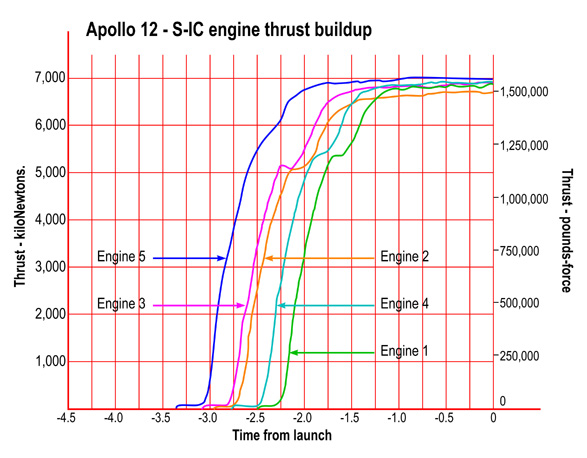
Graph of the thrust of the five F-1 engines during their start-up period. Derived from page 5-3 of the AS-507 (Apollo 12) Flight Evaluation Report
000:00:00 Conrad: Lift-off. The clock's running.
000:00:05 Conrad: I got a yaw program. [Pause.]
000:00:06 Bean (onboard): Six seconds.
000:00:10 Bean (onboard): There's 10 seconds.
000:00:12 Gordon (onboard): Clear the tower.
000:00:14 Conrad: Roger. Clear the tower. I got a pitch and a roll program, and this baby's really going.
Pete Conrad reports the yaw program is in. Tower clear.
000:00:18 Gordon (onboard): Man, is it ever.
000:00:20 Carr: Roger, Pete.
000:00:20 Gordon (onboard): Twenty seconds.
000:00:22 Conrad: It's a lovely lift-off. It's not bad at all. [Pause.]
Pete Conrad reporting the pitch and roll program to put Apollo 12 on the proper course. Altitude at one half mile.
000:00:24 Gordon (onboard): Everything's looking great. Sky's getting lighter.
000:00:26 Conrad (onboard): Okay.
000:00:30 Bean (onboard): Thirty seconds.
000:00:31 Conrad (onboard): Looks good.
000:00:33 Conrad: Roll's complete.
000:00:33 Bean (onboard): This thing moves, doesn't it?
000:00:34 Carr: Roger, Pete. [Pause.]
000:00:37 Gordon (onboard): What the hell was that?
000:00:38 Conrad (onboard): Huh?
000:00:39 Gordon (onboard): I lost a whole bunch of stuff; I don't know...
000:00:40 Conrad (onboard): Turn off the buses.
40 seconds.
000:00:43 Carr: One Bravo.
000:00:43 Conrad (onboard): Roger. We had a whole bunch of buses drop out.
000:00:44 Conrad: Roger. We [garble] on that. [Long pause.]
000:00:45 Bean (onboard): There's nothing - it's nothing...
000:00:47 Gordon (onboard): A circuit...
000:00:48 Conrad (onboard): Where are we going?
000:00:50 Gordon (onboard): I can't see; there's something wrong.
000:00:51 Conrad (onboard): AC Bus 1 light, all the fuel cells...
000:00:52 Multiple speakers (onboard): [Garble.]
000:00:56 Conrad (onboard): I just lost the platform.
Altitude, a mile and a half [nautical, 2.8 km] now. Velocity, 1,592 feet per second [485 m/s].
000:01:00 Gordon: All we've got's the GDC.
000:01:01 Conrad (onboard): Yes.
000:01:02 Conrad: Okay, we just lost the platform, gang. I don't know what happened here; we had everything in the world drop out.
Plus one.
000:01:09 Gordon (onboard): I can't - There's nothing I can tell is wrong, Pete.
000:01:12 Conrad: I got three fuel cell lights, an AC bus light, a fuel cell disconnect, AC bus overload 1 and 2, Main Bus A and B out. [Long pause.]
000:01:21 Bean (onboard): I got AC.
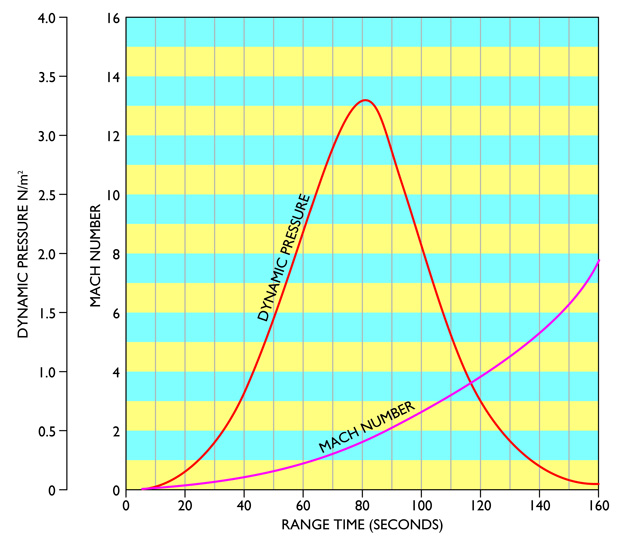
Graph of dynamic pressure and Mach number for the initial ascent of Apollo 12. Derived from page 4-6 of the AS-507 (Apollo 12) Flight Evaluation Report
000:01:22 Conrad (onboard): We got AC?
000:01:23 Bean (onboard): Yes.
000:01:24 Conrad (onboard): Maybe it's just the indicator. What do you got on the main bus?
000:01:26 Bean (onboard): Main bus is - The volt indicated is 24 volts.
000:01:29 Conrad (onboard): Huh?
000:01:30 Bean (onboard): Twenty-four volts, which is low.
000:01:33 Conrad (onboard): We've got a short on it of some kind. But I can't believe the volt...
000:01:36 Carr: Apollo 12, Houston. Try SCE to Auxiliary. Over.
000:01:39 Conrad: Try FCE to Auxiliary.
000:01:41 Conrad (onboard): What the hell is that?
000:01:42 Gordon (onboard): Fuel cell...
000:01:43 Carr: SCE, SCE to auxiliary. [Long pause.]
000:01:45 Conrad (onboard): Try the buses. Get the buses back on the line.
000:01:48 Bean (onboard): It looks - Everything looks good.
000:01:50 Conrad (onboard): SCE to Aux.
000:01:52 Gordon (onboard): The GDC is good.
000:01:54 Conrad (onboard): Stand by for the - I've lost the event timer; I've lost the...
Comm reports the reading is back."
000:01:57 Carr: Mark. One Charlie.
000:01:59 Conrad (onboard): One...
000:02:00 Conrad: One Charlie.
000:02:01 Gordon (onboard): Two minutes. EDS, Auto, is Off.
000:02:03 Conrad (onboard): Yes.
000:02:04 Conrad (onboard): EDS, Auto...
000:02:06 Carr: Apollo 12, Houston. Go for staging.
000:02:10 Conrad: Roger. Go for staging we had some really big glitch, gang?
Flight Director Gerry Griffin taking a staging status now; Apollo 12 down range 17 miles. Altitude 20 miles.
000:02:13 Gordon (onboard): What do the buses read, Al?
000:02:15 Bean (onboard): Stand by.
000:02:16 Conrad: Inboard [center] engine.
000:02:17 Gordon (onboard): Okay.
000:02:19 Carr: Apollo 12, Houston. Try to reset your fuel cells now. [Long pause.]
000:02:20 Bean (onboard): Reset the fuel cells.
000:02:21 Gordon (onboard): Wait for staging.
000:02:22 Conrad (onboard): Wait for staging, yes.
000:02:23 Gordon (onboard): Hang on.
000:02:24 Conrad (onboard): Hang on.
000:02:25 Gordon (onboard): 25 - 27 - 32.
000:02:38 Conrad (onboard): Got a clock running over here?
000:02:39 Bean (onboard): Yes. Hang on.
000:02:41 Gordon (onboard): There's 41. Hang on, there it is.
000:02:43 Bean (onboard): That's it.
000:02:44 Conrad Gordon (onboard): That's it. That's it.
000:02:45 Bean (onboard): Staging.
000:02:46 Gordon (onboard): Hang on.
000:02:47 Conrad (onboard): Okay, GDC is good.
000:02:48 Conrad: Got a good S-II, gang.
000:02:50 Carr: Roger. We copy, Pete. You're looking good.
Good staging and good thrust on the second stage.

AS12-50-7371 - Window 1, the commander's window on the left side of the Command Module, showing the contamination of its outer surface by water and rocket exhaust from the LET jettison. Image by LPI.
000:02:51 Bean (onboard): Cabin pressure's okay.
000:02:52 Gordon (onboard): We're okay.
000:02:53 Conrad: Okay. Now we'll straighten out our problems here. I don't know what happened; I'm not sure we didn't get hit by lightning.
000:03:00 Gordon (onboard): GDC is good...
000:03:01 Carr: Your thrust is looking good, Pete.
000:03:03 Conrad: Okay. I have a good GDC, and Al has got the fuel cells back on, and we'll be working on our AC buses.
000:02:38 Conrad (continued, onboard): Is that AC bus working?
000:03:10 Carr: Right, Pete. Your fuel cells look good down here.
000:03:12 Bean (onboard): Everything looks good.
000:03:13 Gordon (onboard): Stand by.
000:03:16 Multiple speakers (onboard): [Garble.]
000:03:17 Conrad: Think we need to do a little more all-weather testing.
000:03:18 Gordon (onboard): Tower Jett.
000:03:19 Bean (onboard): Tower Jett.
000:03:20 Gordon (onboard): Okay.
000:03:22 Conrad (onboard): There goes the tower, gang; that's away clean. It looked good.
000:03:24 Conrad: There goes the tower, gang; that's away clean. It looked good.
000:03:28 Carr: Good show, Pete. You're in mode 2.
Launch escape tower has been jettisoned on schedule. And we confirm the engines for separation also. Down range 122 [nautical] miles [226 km]; altitude 61 [nautical] miles [113 km]; velocity 10,000 feet per second [3,000 m/s].
000:03:30 Conrad: Roger. In mode 2. No sweat. [Long pause.]
000:03:31 Gordon (onboard): PPO
2 High.
000:03:34 Bean (onboard): I think that's probably the [garble].
000:03:35 Gordon (onboard): I'll tell you what I think happened. We lost all the fuel cells.
000:03:39 Conrad (onboard): They sure did; they dropped right off the...
000:03:40 Gordon (onboard): We still got them back? We got them back now?
000:03:41 Conrad (onboard): Yes.
000:03:42 Bean (onboard): Yes, they look okay.
000:03:46 Conrad: Okay. We've got an ISS light on, and we've got a cycling CO
2 partial pressure high, which I don't - bother me particularly, and we have reset all the fuel cells. We have all the buses back on the line, and we'll just square up the platform when we get into orbit.
000:04:03 Carr: Roger, Pete. That sounds good.
000:04:04 Gordon (onboard): What's that PPO
2 I want?
000:04:07 Conrad: Hey, that's one of the better SIM's, believe me.
000:04:12 Conrad (onboard): Phew! Man alive! I'll tell you what happened...
000:04:13 Carr: We've had a couple of cardiac arrests down here, too, Pete.
000:04:16 Conrad: There wasn't any time for that up here. We've got a good clock running here, and correct me, I'm going to give you a mark at 4 plus 30. I've lost my event timer. And...
000:04:31 Conrad: 4 plus 30.
000:04:34 Carr: Looks good, Pete.
000:04:36 Conrad: Okay. We're all organized again, gang.
000:04:39 Gordon: The only thing we've lost now is the ISS. That number 1 ball is just drifting all over the place, and we'll have to catch it later.
000:04:42 Carr: Roger, Dick.
000:04:44 Conrad: We'd like to have the G&C guys think about how we're going to get that thing, because it's just drifting, just floating.
000:04:49 Carr: Okay. We're thinking. [Long pause.]
The trajectory is right down the lines on the plot board. Altitude is 85 [nautical] miles [157 km] now.
000:04:52 Gordon (onboard): Stand by 5 minutes.
000:04:55 Bean (onboard): Can't say that I've ever seen that before. Man alive...
000:04:58 Conrad (onboard): How about - Let me give it a Verb 40, Noun 20?
000:05:00 Gordon (onboard): Let's not - let's not do anything until we get into orbit...
000:05:01 Bean (onboard): Yes.
000:05:02 Conrad (onboard): Let's just lock it up.
000:05:03 Gordon (onboard): Huh?
000:05:04 Conrad (onboard): Let's lock it up.
000:05:05 Gordon (onboard): No, let's let the ground worry about...
000:05:06 Carr: 12, Houston. We won't be sending you an S-IVB to COI call.
000:05:10 Conrad: Okay, understand. And can you give us the good words like let's get that DSKY - I mean the IMU calmed down. It's rolling all over the place.
000:05:20 Carr: Pete. And if you do a Mode IV, it'll be on the backup.
000:05:24 Conrad: Yes, no sweat. I got a good SCS.
000:05:26 Carr: Okay. Good show.
000:05:29 Conrad: I got a little vibration of some kind - She's chugging along here, minding her own business, though.
000:05:33 Gordon (onboard): How's the pressures?
000:05:36 Carr: Okay, Pete.
Velocity is 13,500 feet per second [4,100 m/s] now. Altitude 92 [nautical] miles [170 km]; Apollo 12 down-range, 345 [nautical] miles [639 km].
000:05:38 Gordon (onboard): How are the pressures?
000:05:39 Conrad (onboard): What pressures? Oh, those...
000:05:41 Gordon (onboard): Tank pressures.
000:05:42 Conrad (onboard): Fine. Well...
000:05:44 Bean (onboard): Cabin pressure's good.
000:05:46 Conrad (onboard): ...I got to get - I got to get organized. What time is it?
000:05:49 Gordon (onboard): Call it 04:59.
000:05:50 Bean (onboard): 05:50.
000:05:51 Gordon (onboard): 05:50.
000:05:52 Gordon: Stand by for the gimbal motors, Houston at 06:00.
000:05:53 Gordon (onboard): 05:50.
000:05:54 Conrad (onboard): Okay.
000:05:55 Gordon (onboard): Stand by, Al, for gim...
000:05:56 Carr: Roger, 12. [Pause.]
000:05:57 Gordon (onboard): God darn Almighty! Wasn't that something, babe?
000:05:59 Conrad (onboard): [Laughter.]
000:06:00 Gordon (onboard): You know what it did? I know what it is; it knocked - it just took all the fuel cells off the line...
000:06:04 Conrad (onboard): Yes, it did.
000:06:05 Bean (onboard): Yes, but what the hell did it?
000:06:06 Carr: Apollo 12, Houston. Level sense arm, 8 plus 37; cut-off, 9 plus 11.
000:06:13 Conrad: Okay. Here comes the gimbal motors. [Long pause.]
000:06:14 Conrad (onboard): Ready, Al? Pitch 1.
000:06:15 Bean (onboard): Go, babe.
000:06:16 Gordon (onboard): 06:16.
000:06:17 Bean (onboard): You got it.
000:06:18 Conrad (onboard): Okay. Yaw 1.
000:06:19 Bean (onboard): You got it.
000:06:20 Conrad (onboard): Okay. Here comes 2.
000:06:24 Bean (onboard): Yes.
000:06:25 Conrad (onboard): And here comes 2. Okay. I think the thing that probably got the ISS was the low voltage. I don't know.
The level sense arm initiates the staging sequence that will be at 8 minutes, 37 seconds. We are in 6:25 now.
000:06:32 Gordon (onboard): Yes. Yes, it just fell open.
000:06:39 Carr: S-IVB to orbit.
000:06:41 Conrad: S-IVB to orbit. [Long pause.]
The S-IVB now has the capability to put the Apollo 12 spacecraft into orbit should something happen to the second stage.
000:06:43 Gordon (onboard): Man, oh man...
000:06:44 Bean (onboard): Isn't that a...
000:06:45 Conrad (onboard): Wasn't that a SIM they ever gave us?
000:06:46 Gordon (onboard): Jesus!
000:06:50 Conrad (onboard): [Laughter.]
000:06:51 Gordon (onboard): That was something else. I never saw so many...
000:06:52 Conrad (onboard): [Laughter.]
000:06:54 Gordon (onboard): ...There were so many lights up there, I couldn't even read them all.
000:06:55 Conrad (onboard): [Laughter.]
000:06:57 Gordon (onboard): There was no sense reading them because there was - I was - I was looking at this; Al was looking over there...
000:07:02 Conrad (onboard): Everything looked great [laughter] except we had all the lights on...
000:07:05 Carr: Apollo 12, Houston. You're right smack dab on the trajectory; your IU is doing a beautiful job.
000:07:10 Conrad: Okay. We're all chuckling up here over the lights. We all said there were so many on we couldn't read them. [Long pause.]
Downrange, 557 [nautical] miles [1,032 km] now.
000:07:24 Conrad (onboard): How about a Verb 40 Noun 20 or something to - to lock up that...
000:07:29 Carr: 12, Houston. Give us Omni Delta.
000:07:31 Bean (onboard): Okay.
000:07:32 Conrad: Roger. Going to Omni Delta. [Pause.]
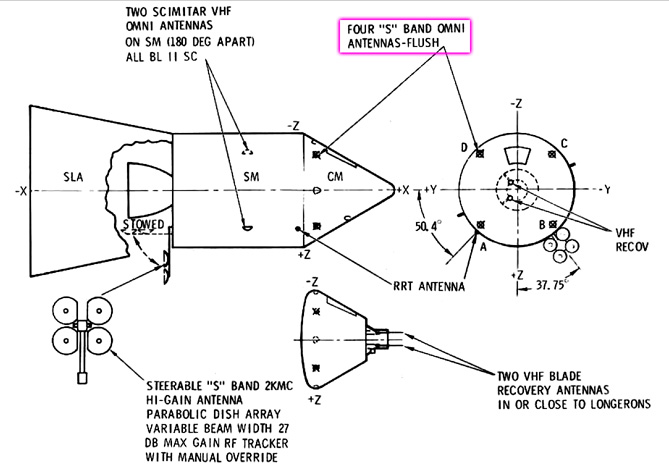
Diagram from the Apollo Operations Handbook for the CSM showing the locations of all the spacecraft's antennae with the omnidirectional antennae pointed out.
Altitude 100 [nautical] miles. Velocity 18,417 feet per second [5,614 m/s].
000:07:33 Bean (onboard): How about your...
000:07:34 Conrad (onboard): Hey, how about that? Get that on. Yes.
000:07:35 Gordon (onboard): Got them. I got them on a while ago.
000:07:36 Conrad (onboard): Okay. Good show.
000:07:38 Bean (onboard): Son of a gun.
000:07:39 Gordon (onboard): What are we up to, 2g's?
000:07:40 Conrad (onboard): [Laughter.]
000:07:41 Gordon (onboard): Oops! Oops, center engine.
000:07:42 Conrad: Center engine. [Long pause.]
Center engine out on schedule.
000:07:43 Gordon (onboard): Wake up!
000:07:44 Conrad (onboard): [Laughter.]
000:07:46 Conrad (onboard): [Garble] is something! [Laughter.]
000:07:47 Bean (onboard): That's known as the LMP's nightmare [laughter].
000:07:50 Conrad (onboard): [Laughter.]
000:07:52 Bean (onboard): Sure it is.
000:07:53 Gordon (onboard): Well, I'm - I'm starting to worry about this platform now, gang.
000:07:55 Conrad (onboard): Yes.
000:07:57 Carr: Apollo 12, Houston. We can start getting that platform squared away. Go IMU power, Standby, and then back to on, and we'll get her caged up. [Pause.]
000:08:05 Gordon (onboard): IMU, Power.
000:08:07 Conrad (onboard): Power. Okay.
000:08:11 Gordon (onboard): Standby, Proceed.
000:08:12 Conrad (onboard): Okay.
000:08:17 Conrad: We'll wait until we get through staging here, I think, Houston.
000:08:20 Carr: Okay. Soon as you can reach it; that's the way to go.
000:08:22 Gordon (onboard): Where the hell is it?
000:08:23 Conrad (onboard): IMU Power's over on [garble]...
000:08:24 Gordon (onboard): Oh, [garble] side.
000:08:25 Carr: Apollo 12, Houston. Go for staging.
000:08:28 Conrad: Roger. We're Go for staging.
000:08:31 Bean (onboard): [Garble] - G&N Power [garble]?
000:08:35 Gordon (onboard): Yes.
000:08:36 Conrad: Okay. You want the LMP to turn off the G&N power and then bring it back on, and you want me to use IMU cage switch, is that right?
000:08:XX Gordon (onboard): No. Don't hit that Caging switch...
000:08:XX Bean (onboard): No, no, no.
000:08:44 Carr: Stand by on that, Pete. [Long pause.]
000:08:47 Gordon (onboard): Don't hit that Cage switch.
000:08:48 Bean (onboard): 08:48.
000:08:50 Conrad (onboard): Okay. Stand by.
000:08:51 Bean (onboard): 08:50.
000:08:54 Conrad (onboard): 09:11 is shutdown? Huh?
000:08:58 Gordon (onboard): Yes, 09:11.
Second stage engine shutdown is predicted for 9 minutes, 11 seconds. We are at 9 minutes now.
000:09:02 Conrad (onboard): I think we got hit by lightning.
000:09:04 Gordon Bean (onboard): I do, too.
000:09:06 Gordon (onboard): Something took care of those panels, I'll say that for it.
000:09:10 Conrad (onboard): [Garble.]
000:09:11 Bean (onboard): 09:10.
000:09:12 Bean (onboard): 09:11, Dick.
000:09:13 Conrad (onboard): Two [garble].
000:09:14 Multiple speakers (onboard): [Garble.]
000:09:15 Conrad (onboard): Okay. Looks good.
000:09:16 Bean (onboard): You staging?
000:09:17 Gordon (onboard): Yes. See the throttle?
000:09:18 Conrad (onboard): Okay. There you go.
000:09:19 Conrad: Got a good S-IVB; nice, smooth staging.
000:09:21 Bean (onboard): Look at that stuff go by.
000:09:22 Carr: Roger, Pete. Your thrust looks good.
000:09:24 Conrad: Okay. Give us some more words on the IMU now. [Long pause.]
Velocity is 23,000 feet per second [7,000 m/s]. Down range 967 [nautical] miles [1,791 km]. Altitude 102 [nautical] miles [189 km].
000:09:30 Bean (onboard): I got ice all over the windows out here, y'all. I got the horiz - don't have the horizon, but I got the sky.
000:09:38 Conrad (onboard): Pointed down pretty good.
000:09:39 Bean (onboard): Hope those thrusters don't have the ice...
000:09:41 Carr: Stand by a minute, Pete. We're still talking.
000:09:43 Conrad: Okay. [Long pause.]
Good trajectory; good thrust.
000:09:44 Bean (onboard): No, we're - we're in good shape. Where's your card here, Dick? We're at the 9...
000:09:47 Gordon (onboard): Okay. Hold still.
000:09:48 Bean (onboard): ...[garble] low.
000:09:51 Gordon (onboard): Yes. Okay. In 10 minutes, we should be at 246.
000:09:56 Conrad (onboard): That was right on the profile. Good [garble].
000:09:59 Gordon (onboard): Ten minutes.
000:10:01 Conrad (onboard): All right. Get your - get your shutoff checklist out.
000:10:04 Bean (onboard): I got it. Now, listen, Dick, all this - best thing I can...
000:10:06 Gordon (onboard): You haven't pushed this G&N Power, by the way.
000:10:07 Bean (onboard): Yes, yes...
000:10:12 Conrad: Roger. Mode IV.
Mode IV. Apollo 12 could get into orbit now using the Service Propulsion System. Down range 1,160 [nautical] miles [2,148 km], velocity is 24,157 feet per second [7,363 m/s], altitude 103 [nautical] miles [191 km].
000:10:14 Gordon (onboard): I got a restart - I got a Restart Program alarm, and all [garble] - there's the Gimbal Lock. Get it out of gimbal lock. [Garble] my timer, I [garble].
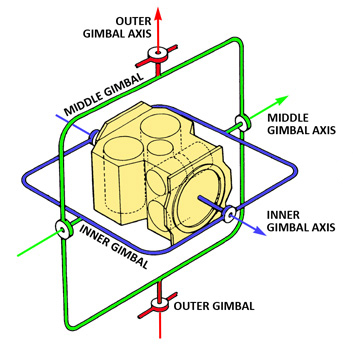
Diagram to illustrate a three-gimbal system.
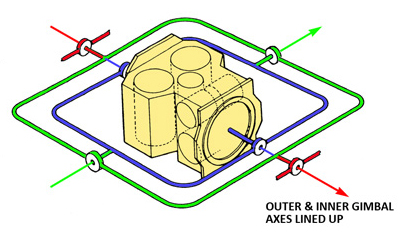
Diagram to illustrate the concept of gimbal lock.
000:10:28 Bean (onboard): Well, this one's running.
000:10:35 Gordon (onboard): [Garble.]
000:10:36 Bean (onboard): [Garble] 36.
000:10:38 Gordon (onboard): Shutdown. We've got less than a minute to shutdown.
000:10:45 Conrad (onboard): Now get the gimbal motors off...
000:10:48 Bean (onboard): Got about a half a g.
000:10:50 Gordon (onboard): Yes, sir. We're getting [garble]...
000:10:52 Conrad: Well, I'll tell you one thing. This is a first-class ride, Houston.
000:10:53 Gordon (onboard): [Garble] just do it right.
000:10:57 Carr: Kind of a rough start.
000:11:00 Conrad: Yes. I always like to start out behind the eight-ball and get ahead.
Estimating cut-off at 11 minutes, 35 seconds.
000:11:05 Bean (onboard): Cabin pressure looks good.
000:11:08 Conrad (onboard): Yes, we ought to get shutdown here in about...
000:11:09 Carr: 12, Houston. Cut-off, 11 plus 35.
000:11:12 Gordon (onboard): 35.
000:11:14 Conrad: 11 plus 35. Roger. Roger. [Long pause.]
000:11:XX Conrad (onboard): We get this platform - turned up on the S-IVB.
000:11:17 Gordon (onboard): I hope we can iron out...
000:11:19 Conrad (onboard): I hope.
000:11:21 Gordon (onboard): Yes, I do too. [Garble].
000:11:24 Bean (onboard): I don't either. I think it was the low voltage; it just fell off. Maybe it got hit.
000:11:29 Conrad (onboard): Okay. Stand by for shutdown.
000:11:30 Gordon (onboard): Stand by. 31, 32 [garble].
000:11:32 Conrad (onboard): There it is...
000:11:33 Conrad (onboard): Shutdown.
000:11:35 Conrad: Shutdown. 11 plus 33, Houston.
000:11:37 Carr: Roger, Pete. [Long pause.]
Flight Dynamics reported it looks like a good orbit. Showing velocity 25,561 feet per second [7,791 m/s]. Down range 1,450 [nautical miles, 2,685 km]. FIDO. FIDO says we are Go.
000:12:16 Carr: Apollo 12, Houston. Before you get down there to work on that switch, try pulling on panel 5, your IMU main A and main B breakers.
000:12:30 Gordon: Okay. That did it. They're both out. Now what do you want us to do?
000:12:37 Carr: Your S-IVB safe now. Stand by.
000:12:41 Carr: You've got a go orbit. You're looking good. [Long pause.]
That's CapCom Jerry Carr talking to Pete Conrad. The backup crew commander Dave Scott is also at the CapCom console here.
000:13:25 Carr: 12, Houston. Your S-IVB is looking good. You are configured for orbit.
000:13:30 Conrad: Roger, Houston.
000:13:37 Carr: Roger, 12. Your orbit is 102.5 by 100 [nautical miles, 189.8 by 185.2 km].
000:13:44 Conrad: At least that didn't lose it. [Pause.]




